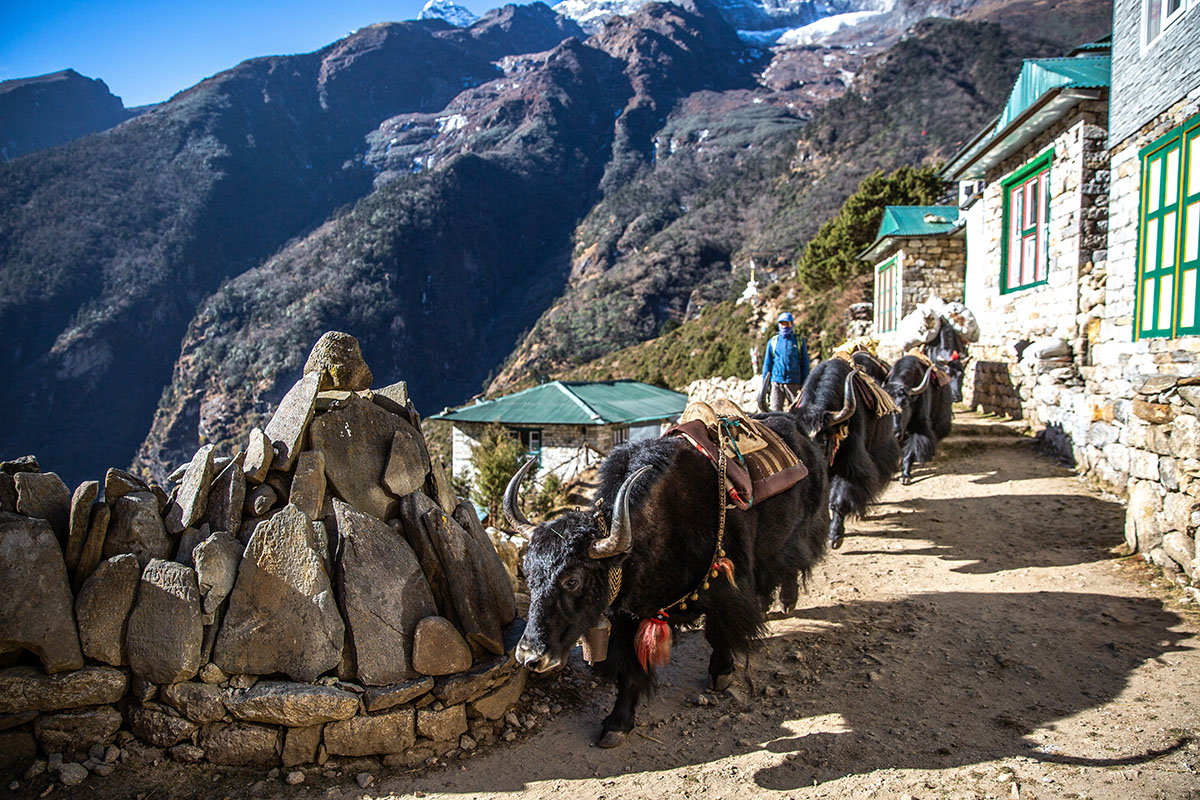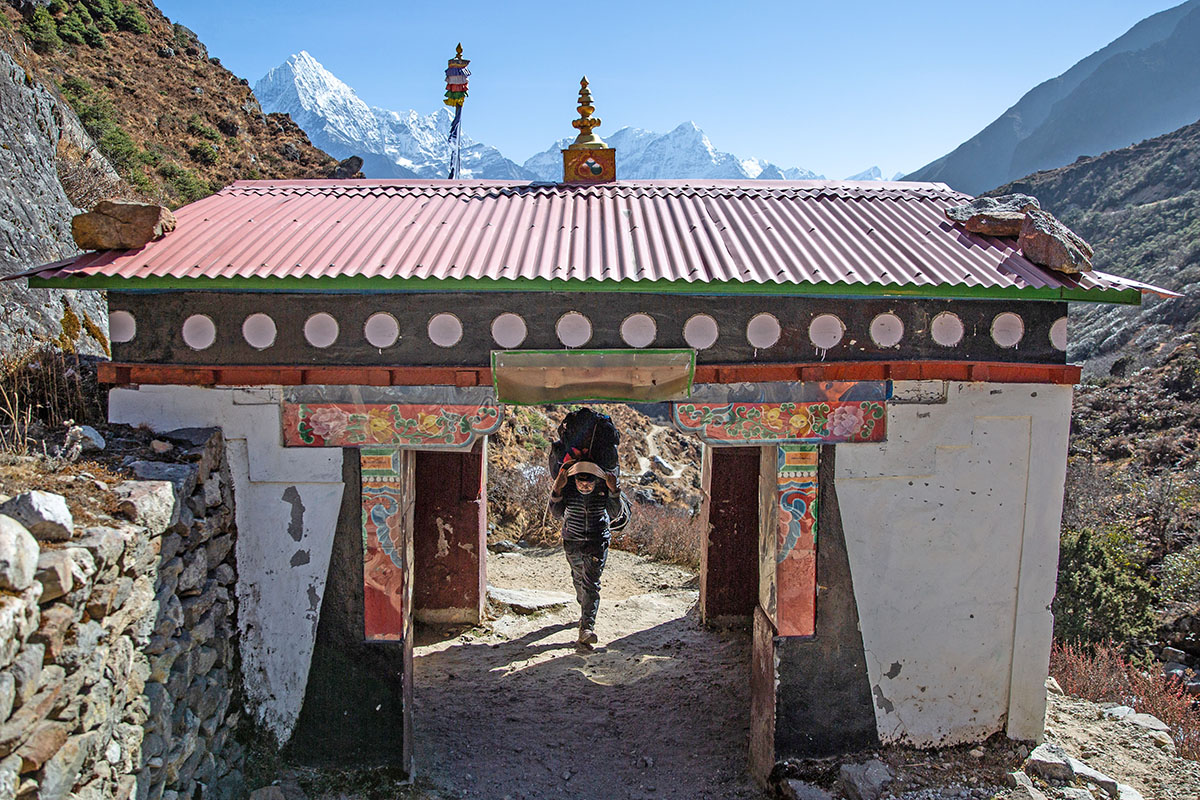
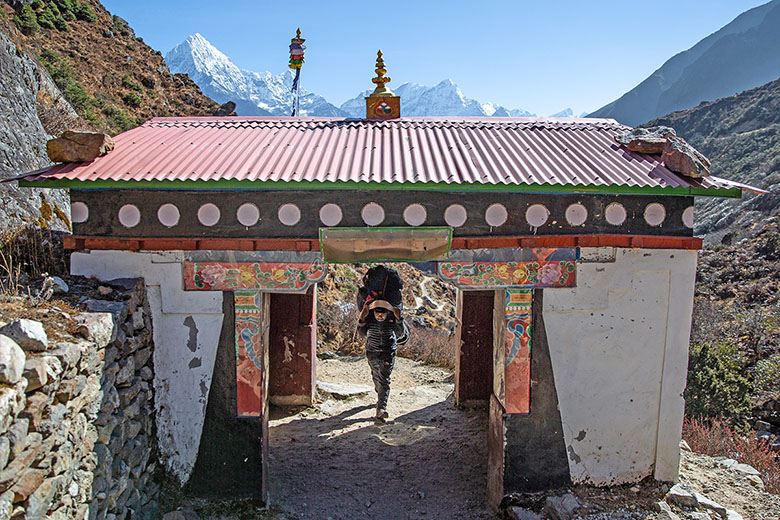
Exhausted and oxygen-deprived, we high-fived as frigid winds took our already limited breath away and whipped at the prayer flags that marked the summit. We were about an hour early for sunset, and the extra time allowed us to bundle up, look around, and find a more sheltered location from which to watch the sunset on Everest, or Sagarmāthā in the Nepali language. We were on Kala Patthar at 5,644 meters, and the sky was turning pink. No clouds obscured our view of the highest mountain on Earth. Everything felt right in the world, and quite simply, it felt magical.
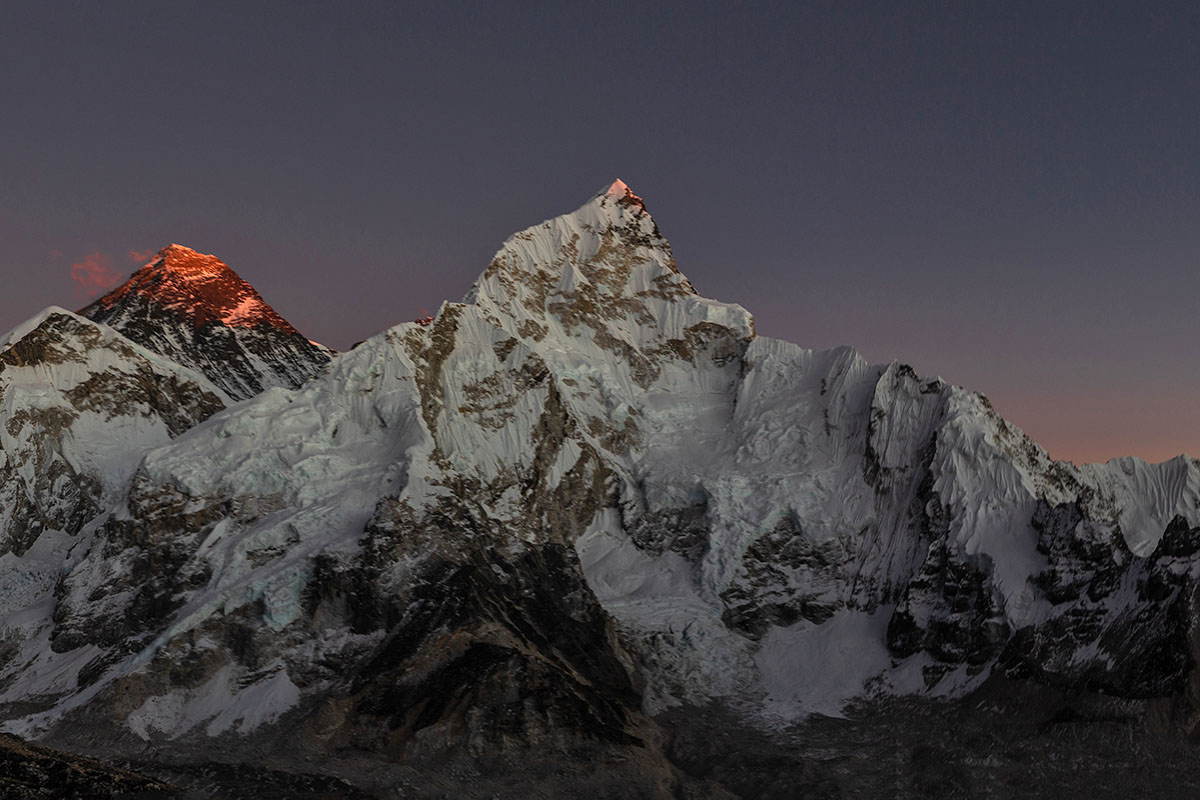
The cockpit of our small plane had no curtain or door, and the flashing lights were hard to ignore. The pilot and co-pilot glanced down to see "Terrain Hazard, Terrain Hazard" and "Too Low, Too Low," but otherwise seemed unperturbed. I looked out the plane's window and saw only white. Our flight had been delayed by seven hours due to weather that made it impossible to land at the Tenzing-Hillary airport in Lukla, a landing strip with the unfortunate reputation of being the "most dangerous airport in the world." Though we were able to depart Kathmandu, the clouds were still thick, and the flight attendant had only one rule on this flight: We were not allowed to photograph or video the cockpit.
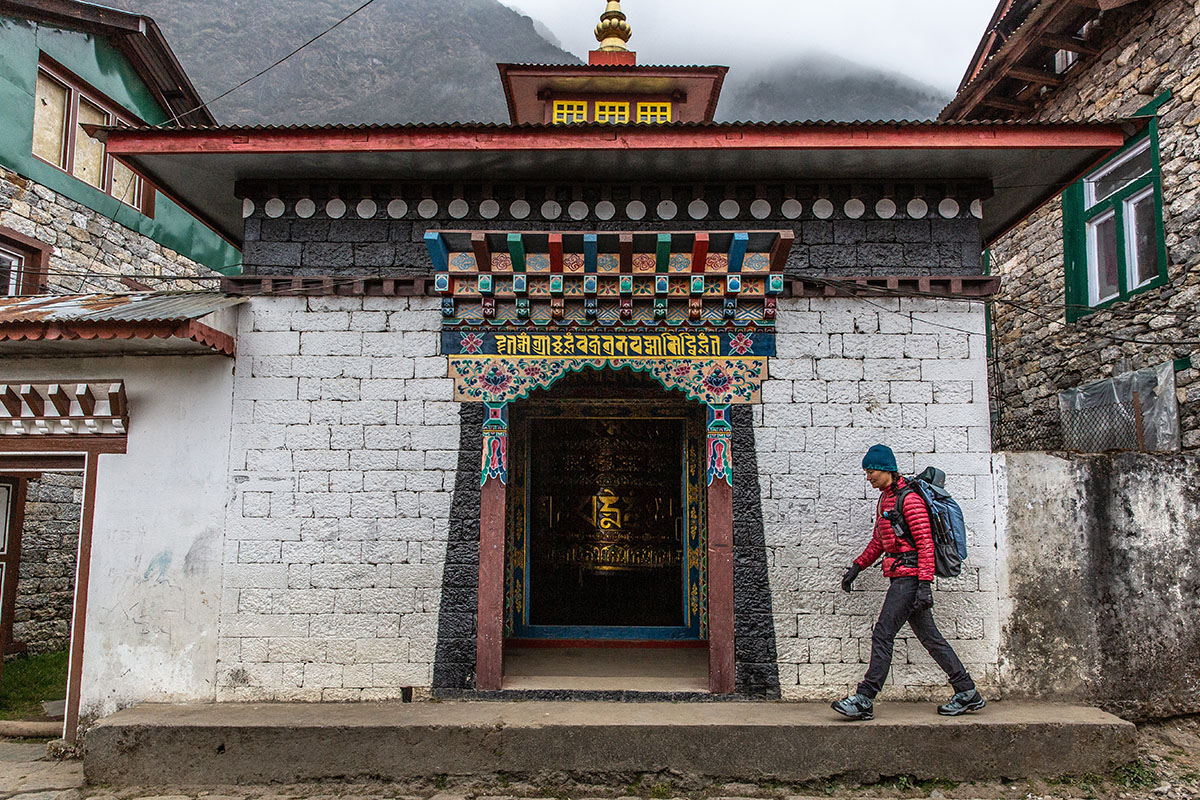
Brian and I made eye contact and shrugged—we'd both seen the flashing lights but had to trust that the pilots knew what they were doing. After some tense moments, there was a small break in the clouds, and we could see the short, steeply uphill runway. Within seconds, we touched down, decelerated quickly, and came to a hard stop. I imagine the other three passengers felt as relieved as we did as everyone disembarked to begin the first day of a 16-day trek. This journey would take us over epic passes, to Everest Basecamp, and to Kala Patthar, where we would watch the sunset on Sagarmāthā. It was certainly an exciting start.
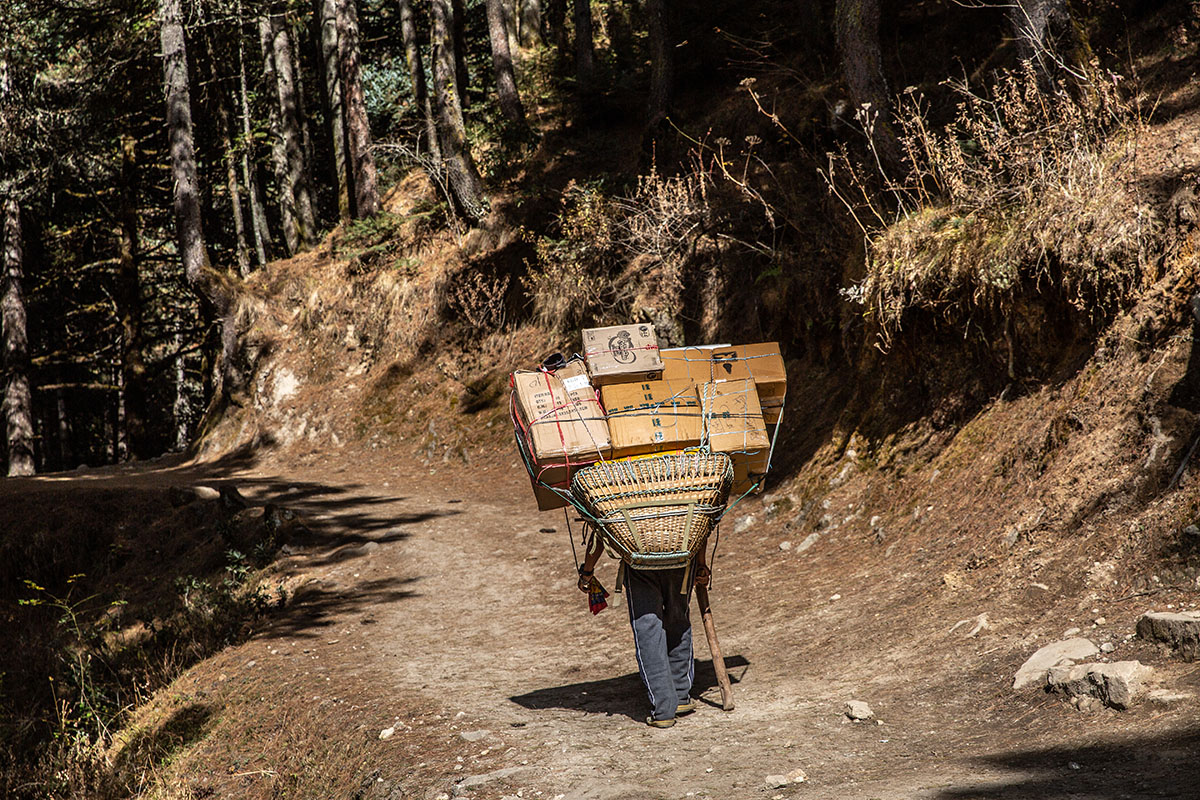
In Lukla, our guide, Ramesh, introduced us to our porter, Prashant, and we had our first meal of dal bhat (lentil soup and vegetable curry with rice). Excited and probably still pumped with adrenalin from our white-knuckle flight, we set off along the milky waters of the Dudh Koshi river, through ponderosa pine trees and rhododendron bushes. We passed Sherpa settlements with vibrant green gardens and beds of marigolds, as cacophonies of bells signaled that we had to make way for donkeys or dzo, a cow/yak hybrid. There are no roads or motorized vehicles—the only route in was this path, traveled by all who trek to Everest.
Though the flora was familiar, the setting was anything but. We felt truly transported. By this point, we'd been in Nepal for less than 24 hours, and the net descent of 200 meters from Lukla (2,800 meters) to Phakding (2,600 meters) was a welcome introduction to the trek.
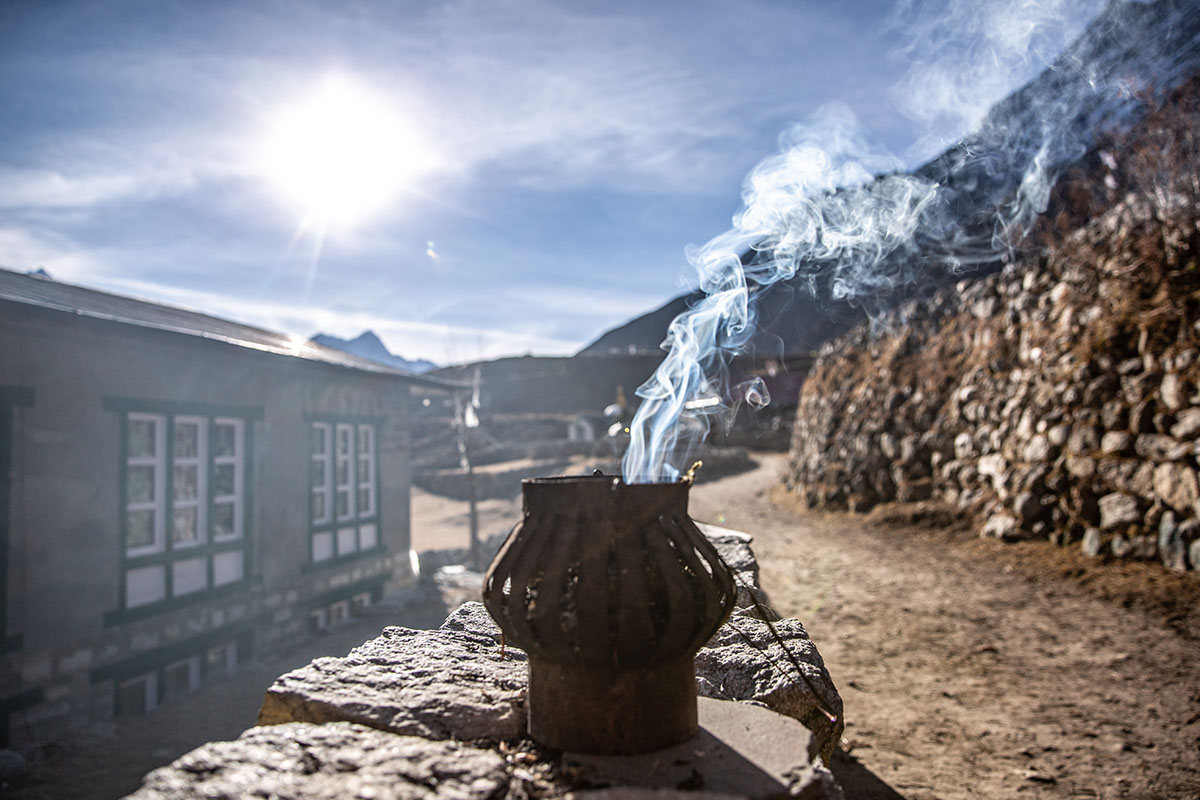
On our second day, we started toward Namche as the sweet smell of incense, made from mountain herbs and offered to the deities, drifted through the valley. This day would provide us with a peek-a-boo view of Everest and crossings of iconic suspension bridges lined with prayer flags. We passed through villages undergoing construction and were astounded and impressed as we watched porters carrying rebar and sheets of plywood, locals making gravel by hand, and others planting trees by hand to create boards.
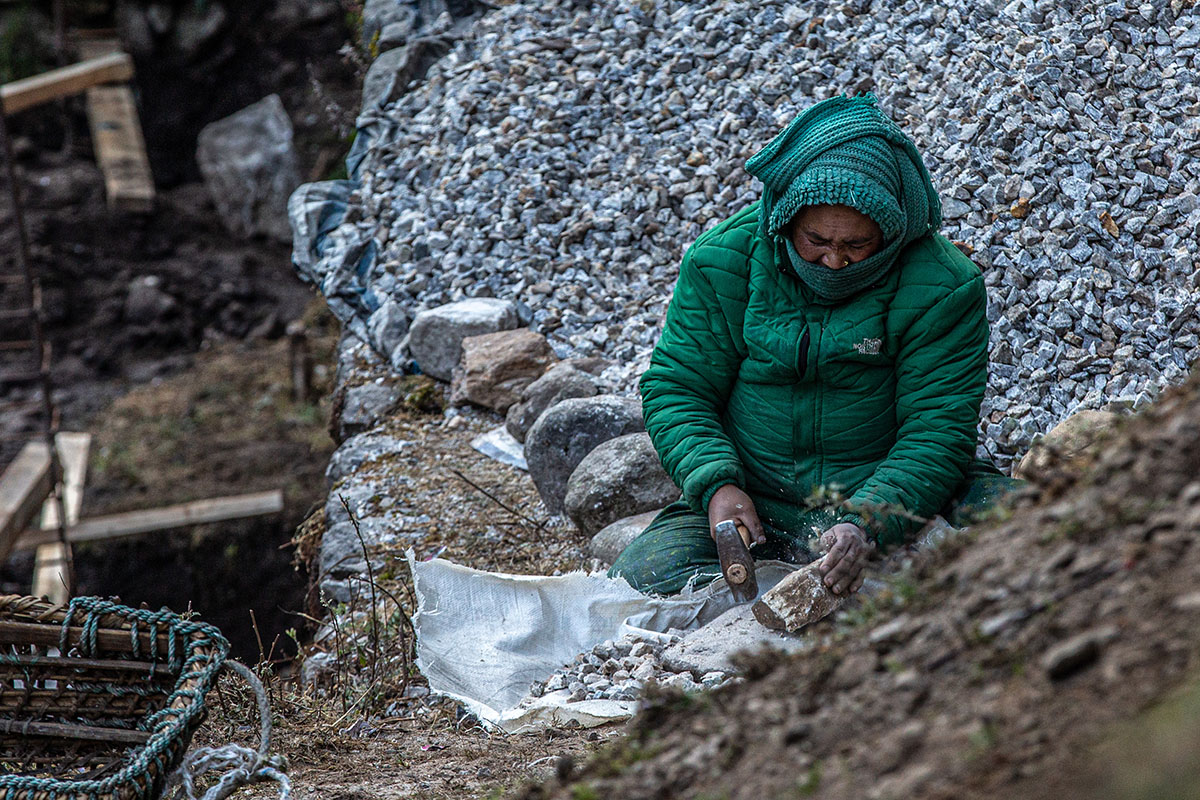
Namche itself is bustling with lodges, restaurants, bars, and gear stores. Each store is bursting at the seams, many with knock-off items (some of which are almost indiscernible from the real thing, and some of which had us giggling at the audacity). The town was so well stocked that it was hard to remember that every supply was carried in by a porter, beast of burden, or helicopter. Because it was late in the trekking season during a pandemic, there were very few trekkers in town, and we were one of only two parties at our lodge. Apparently, during expedition season, when groups of hopefuls attempt to summit Everest, finding a room in Namche is difficult. As we gazed from our window of the Hill-Ten toward dozens of teahouses with names that tended to include words such as Buddha, Everest, Sherpa, or Summit, it was hard to imagine the streets filled with foreigners.
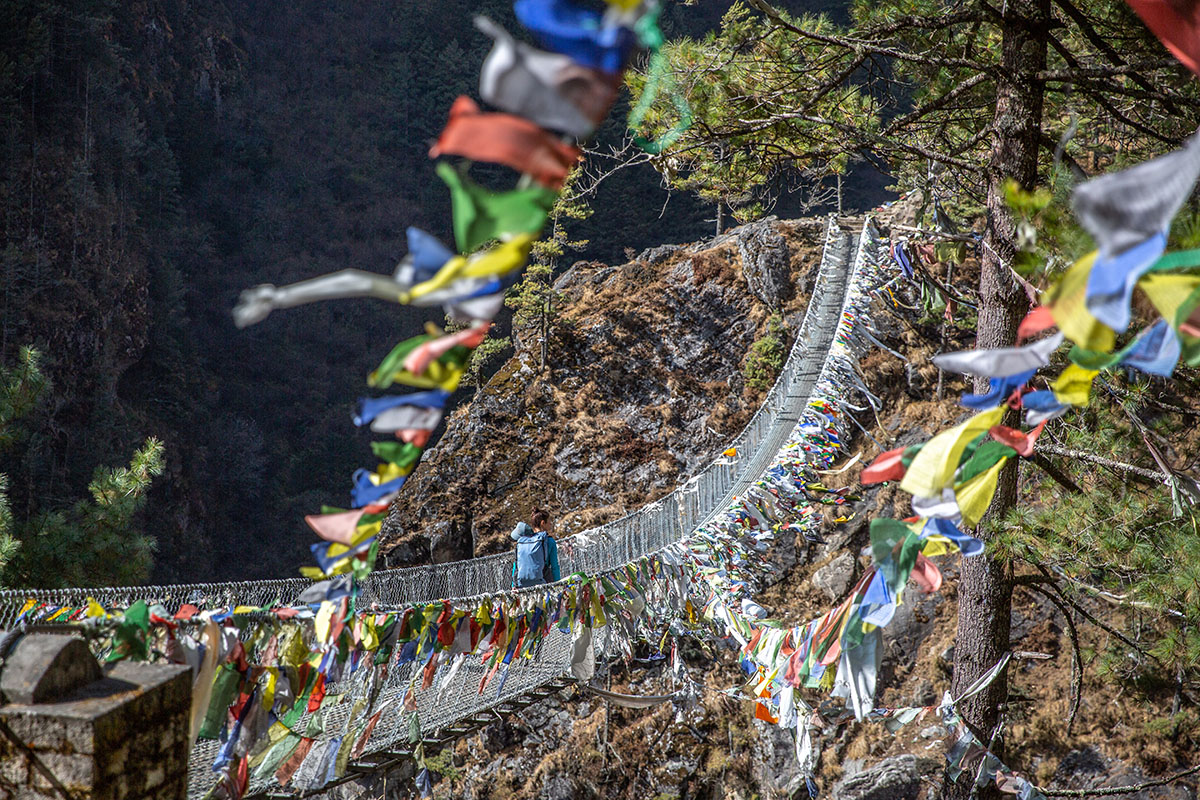
Namche is at 3,400 meters, so it's common to stay a couple of nights to assist with acclimatization, and we decided to enjoy the amenities and spend a day hiking to the Sherpa Museum and the Everest View Hotel (3,800 meters). The aptly named Everest View Hotel gave a clear view of the world's most famous range with Ama Dablam, Lhotse, and Thamserku, and looking down upon all of them—Everest. This view would be but a small glimpse at what awaited us.
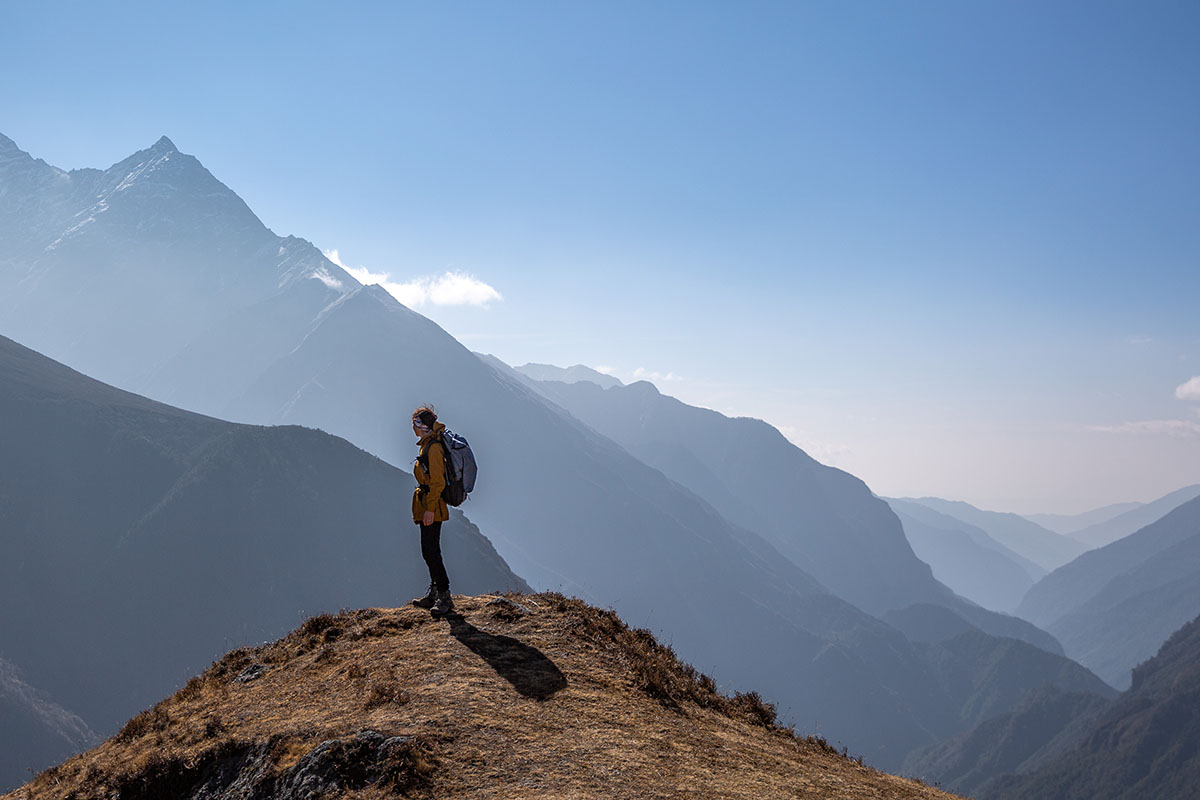
After resupplying with the requisite Snickers and Pringles, two products we never eat at home yet gravitate to while traveling, we headed toward the Sherpa settlements of Thame and Lungden. At this point, our path separated from the main trail that heads to Everest Basecamp. Besides the five dogs that accompanied us for several hours, we had the path to ourselves. The dogs in Nepal are lovely, gentle, and admittedly better behaved than our own pup at home, Otis. They seem to appreciate human company even if they aren't being fed, and we were thrilled to have them along.
As we ascended, the land became less hospitable—there were fewer Sherpa villages and farms, and pine trees gave way to stunted juniper shrubs and grasslands. Donkeys and dzo were replaced by altitude-hardy yaks. Nights became colder, and dung fireplaces mercifully warmed the common seating room in teahouses.
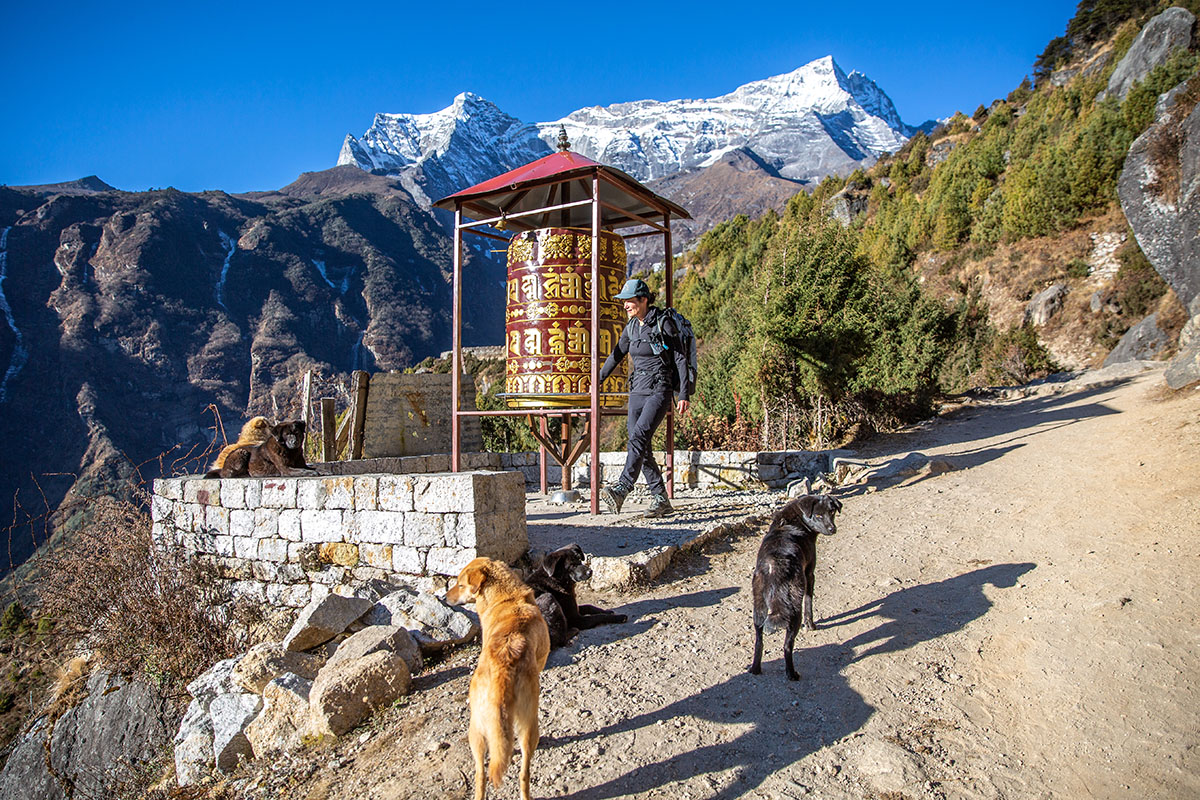
On our fourth night, we visited the Thame Gompa, a picturesque monastery perched above Thame, to help with acclimatization. The mountains felt infused with spirituality as we passed chorten, a series of mani stones, and large boulders covered in Buddhist writings. We spent that evening in awe while reading the walls of the Thame teahouse, plastered with accolades and certificates. We had been told the lodge was owned by the family of Apa Sherpa, a former world record holder for his 21 summits of Everest. Sadly, on August 16, 2024, Thame was devastated by a flash flood after a glacial lake burst. There were no human casualties, but many structures were badly damaged or destroyed, and many people were displaced.
On our fifth night, in Lungden, a small village of less than 50 people perched at 4,500 meters, the air continued to thin, so we planned an early morning start for the next day's Renjo la Pass, which would take us to 5,400 meters.
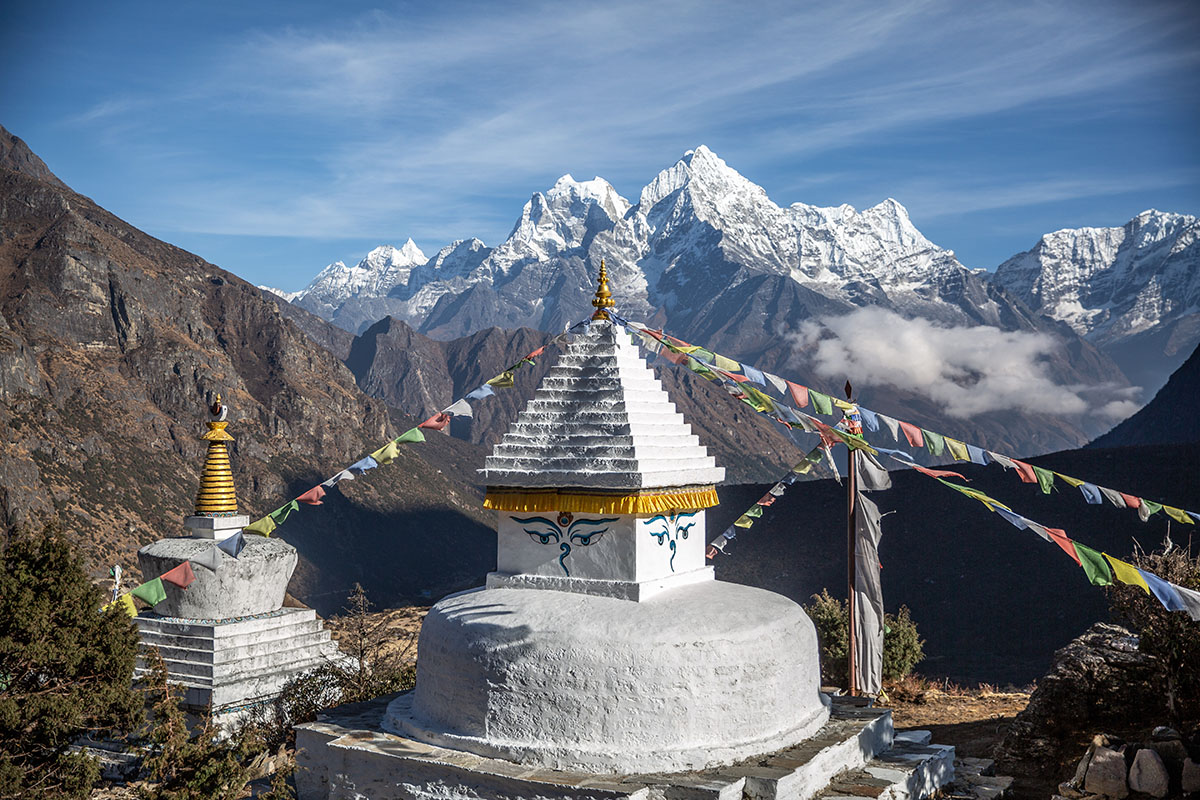
We'd been anticipating and somewhat fearing this day as we'd be ascending to 5,400 meters. Though Brian and I had been at high altitudes before, we were constantly aware that we live at sea level and we'd only allowed our bodies five days to acclimatize. We set out before dawn, full of pancakes and with headlamps on, and began the gradual ascent. As the sun rose, we were able to shed our headlamps but not our jackets. We both had moments of struggle and questioned our life choices. At times, we vowed that our next vacation would be on a beach with tropical drinks, but managed to carry on as we chanted "bistāri, bistārī" (which sounds like "bistali, bistali," and means "slowly, slowly").
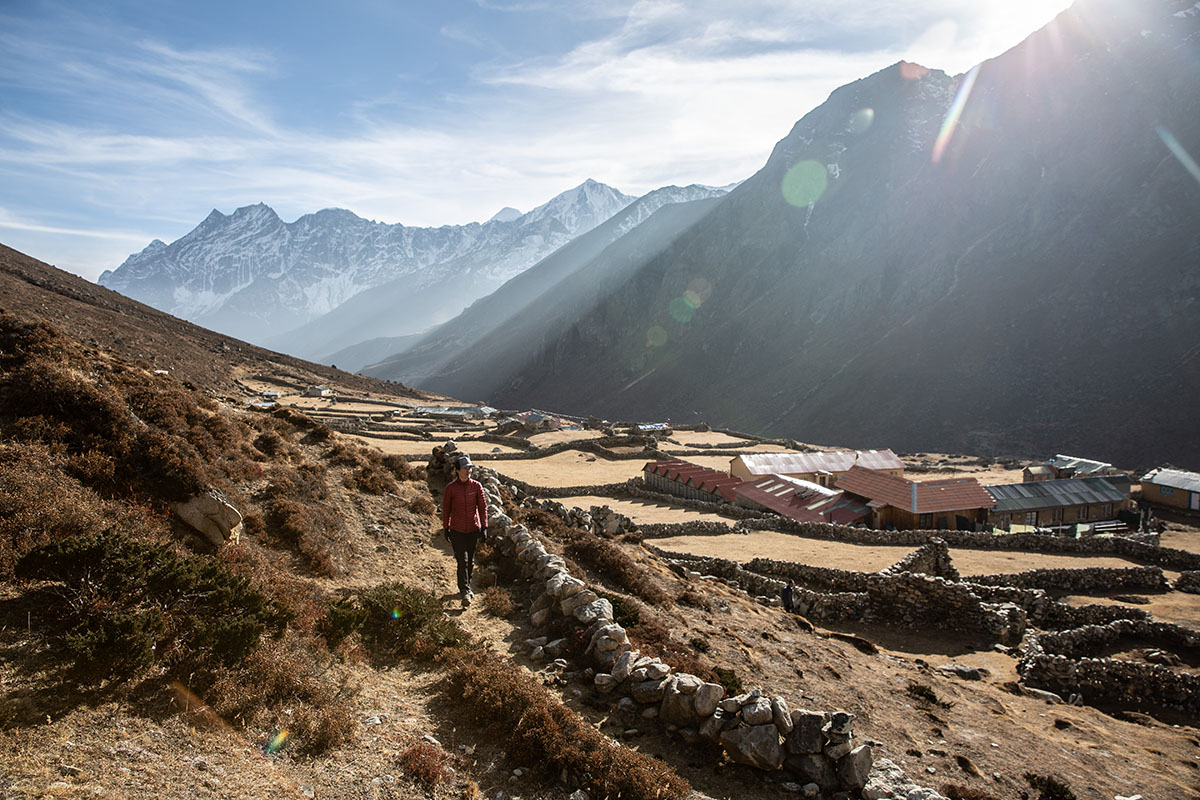
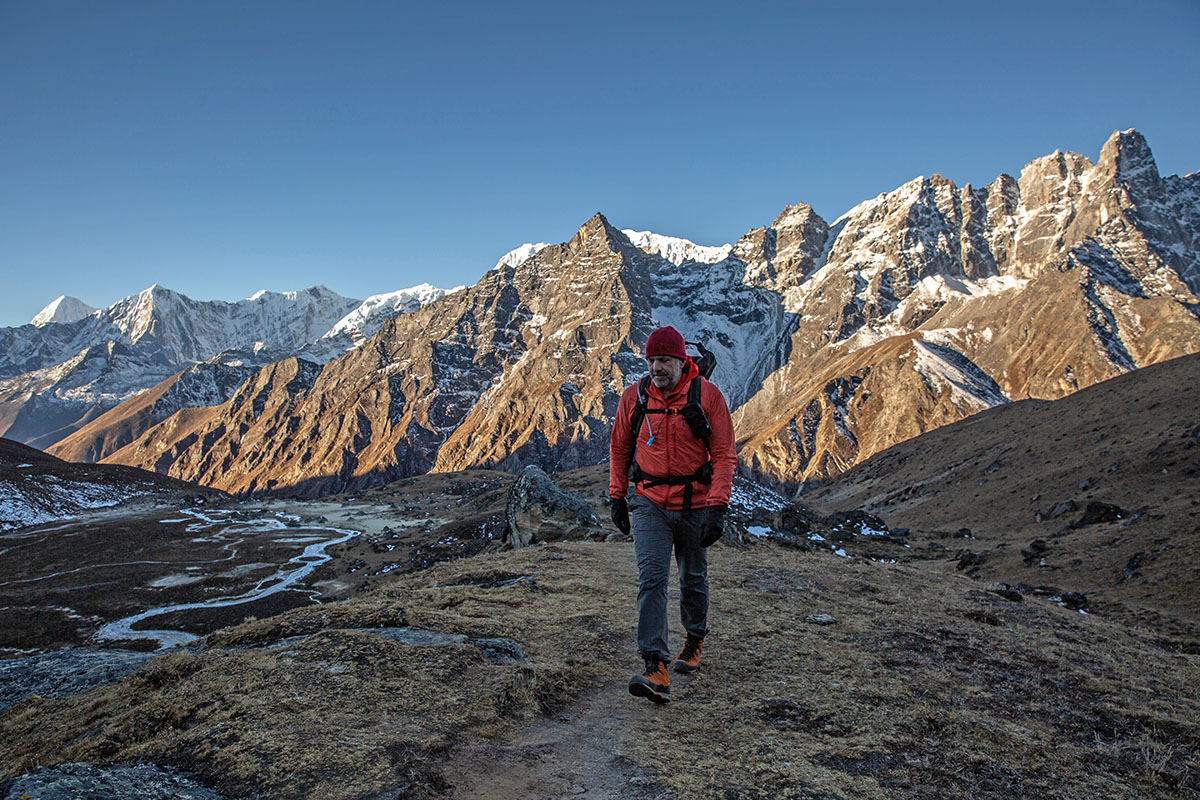
As we passed Renjo Lake, the shifting ice moaned and groaned and encouraged us on. At the crest of the pass, we ducked under prayer flags, and the most amazing view presented itself: Everest, covered in lenticular clouds that resembled a mustache, and the surrounding peaks of Lhotse, Cho Oyo, and Makalu soared above the turquoise Gokyo Lake in the valley. I found the entire setting to be a bit overwhelming as prayer flags danced in the wind with the iconic peaks across the backdrop. It's easily one of the most spectacular views I've ever taken in.
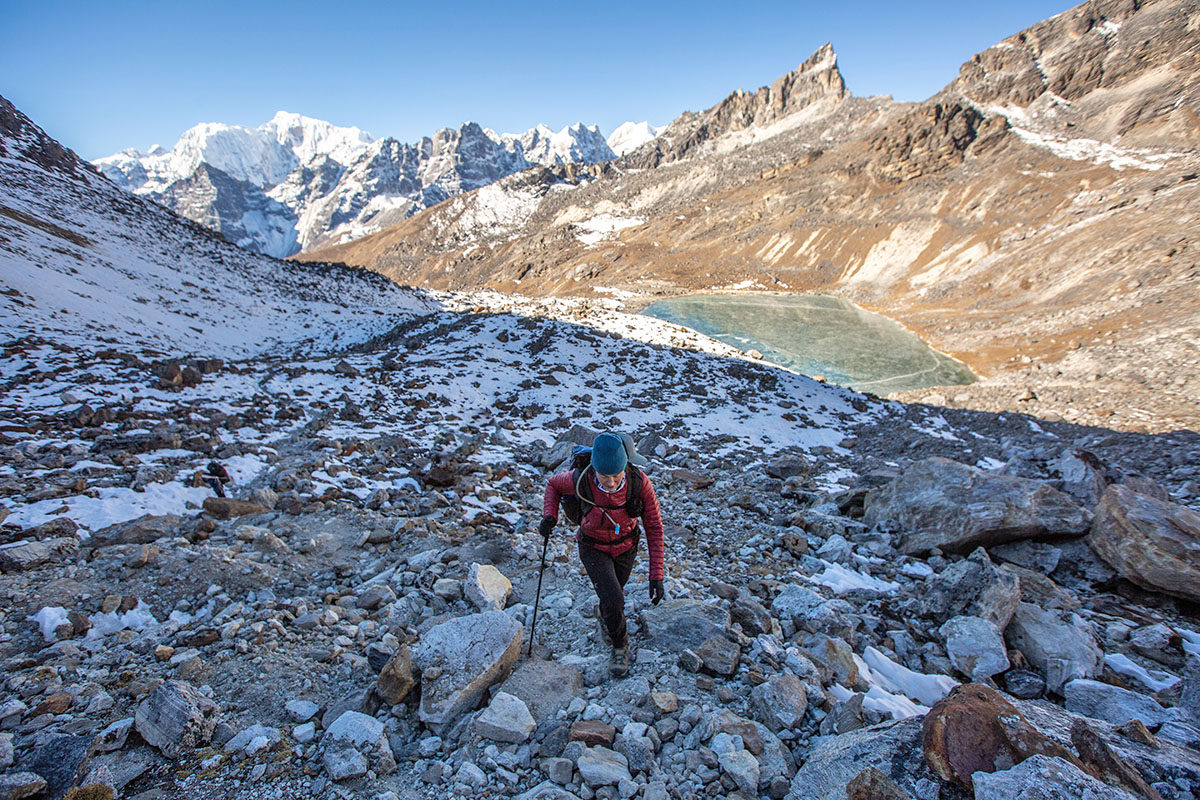
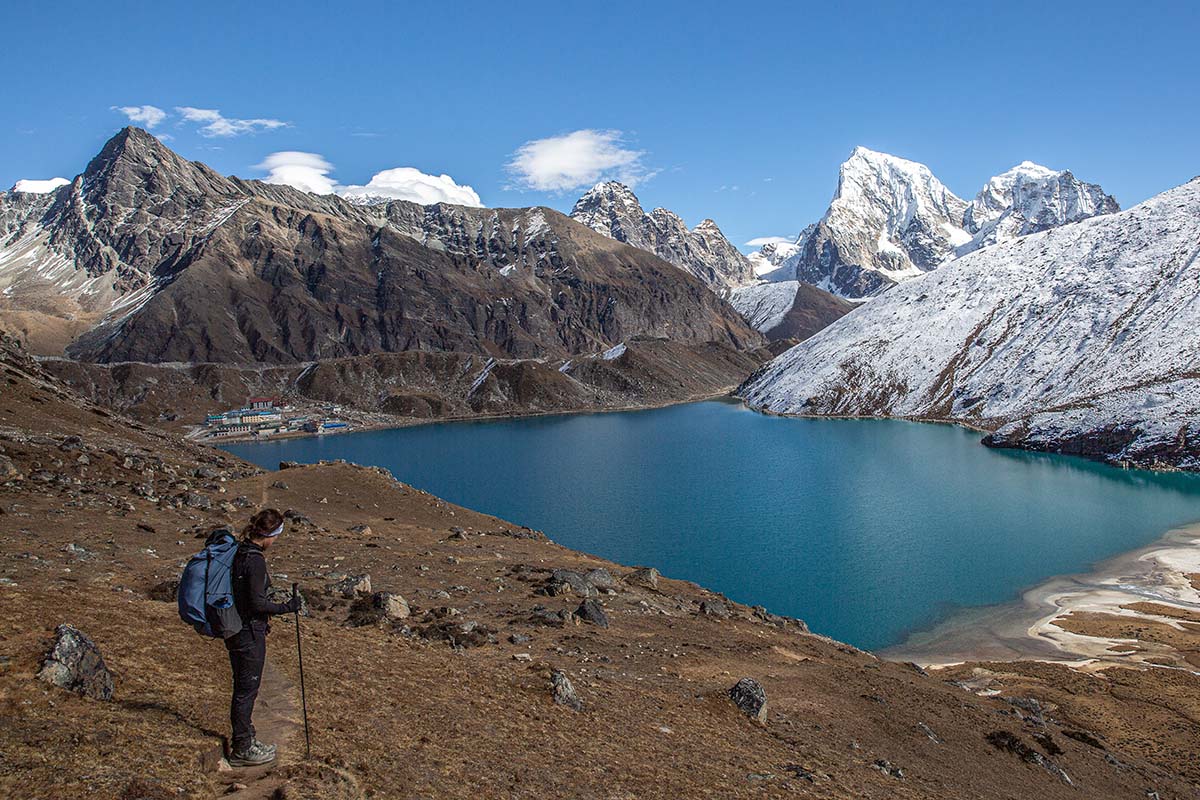
The panorama of 8,000-foot peaks did not let up as we descended, and the teahouses of Gokyo on the lake's edge came into view. We arrived knackered, ate a late lunch of momos and popcorn, and then barely moved. I nursed a minor headache brought on by the elevation, which eased in the evening as we were treated to dramatic clouds and a spectacular sunset over Tibet's Cho Oyo mountain.
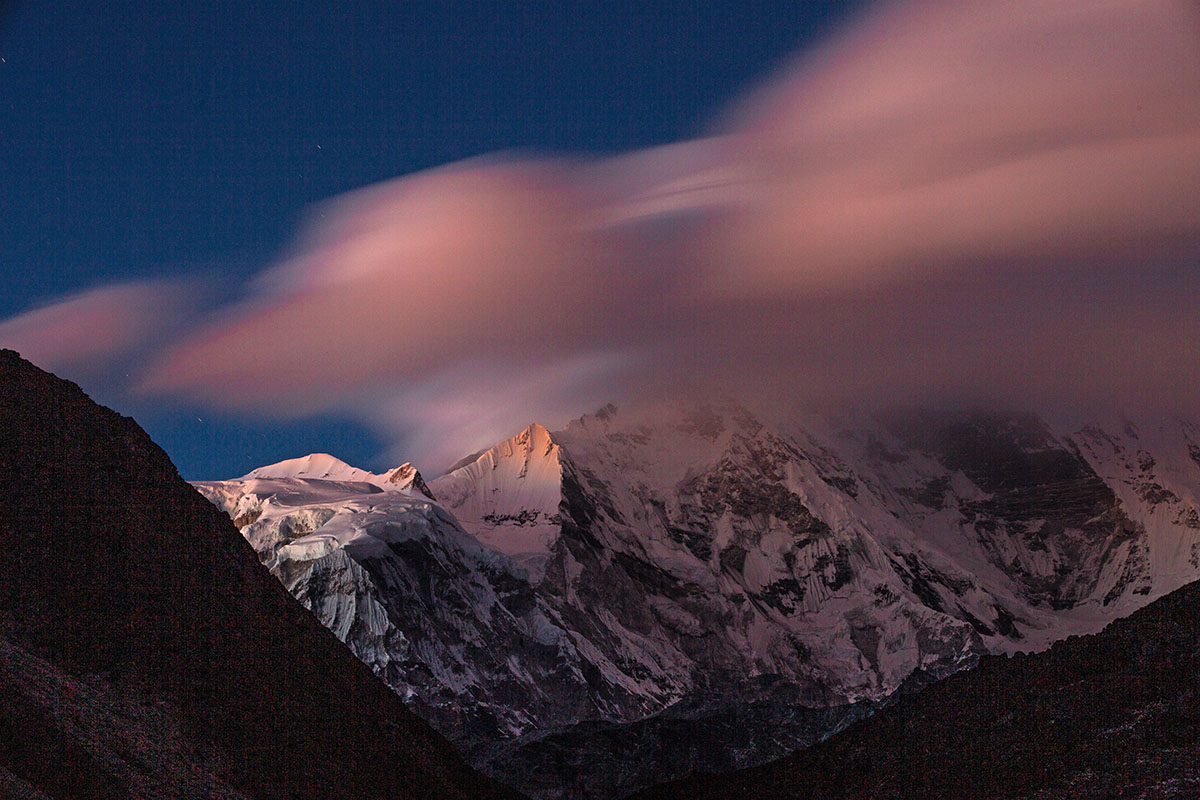
The dramatic clouds continued to roll in, and the weather became uncertain. With snow in the forecast, we decided to push toward our second pass a day early. Unfortunately, this meant forgoing a hike to the summit of Gokyo Ri, but we were fresh off the views from Renjo La Pass, which we'd been told were similar to, but better than, those from Gokyo Ri.
It's a short hike from Gokyo to Thagnak over the Ngozumpa glacier. As we zigged and zagged through rock piles and around glacial ponds, it was clear that the trail was ever-changing in response to the shifting glacier beneath. The sound of rockfall and whoomphing had us quickening our pace to get off the glacier before the heat of the sun hastened the ice melt. We enjoyed the rest of the day in Thagnak, and the views did not disappoint. We were again treated to dramatic skies over the surrounding giants. But snow flurries threatened, and we went to bed hoping that the morning would bring clear skies for Chola Pass the next day.
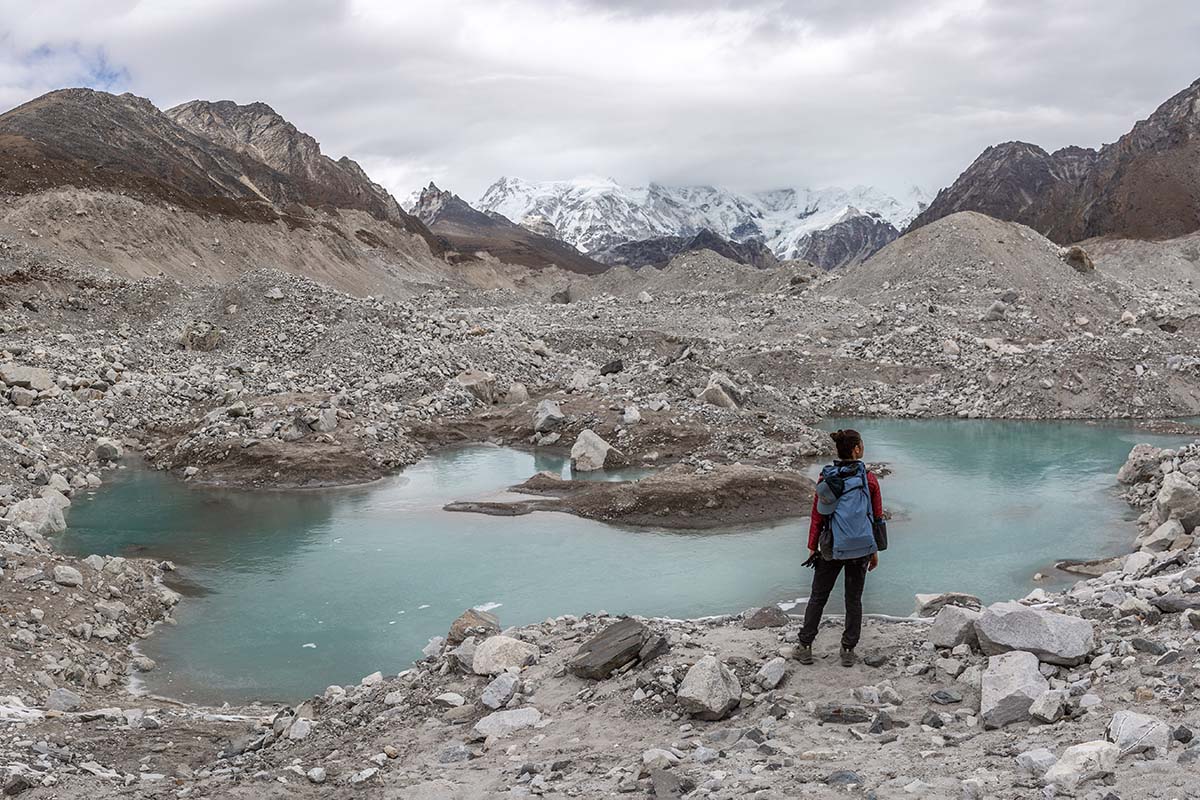
Light snow fell, but stars were visible when we woke, and as the sun rose, we could see the path to the pass. We headed out at first light and started the ascent, again repeating "bistāri, bistārī." We both felt strong and acclimatized as we looked back to the layers of mountains and the valley behind us. The skies continued to clear, and our fears of snow or a white-out were put to rest.
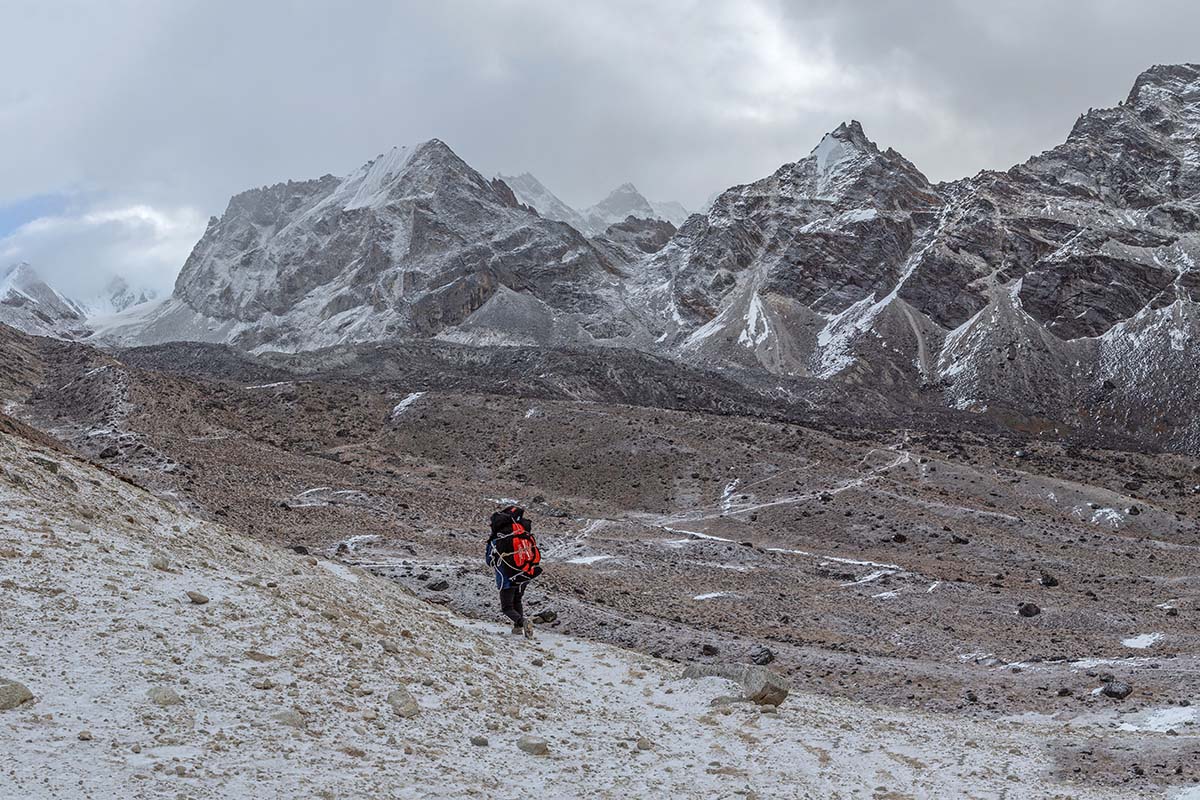
Beckoned by the string of prayer flags visible on the pass, we pressed on, stopping only to take pictures and to put on microspikes when the ice became treacherous. At the pass, the spectacular view of Cholatse dominated. We reveled in our success and took celebratory photos before beginning our descent. As we descended, picturesque Ama Dablam stole the show. Though not the tallest peak at just over 6800 meters, Ama Dablam quickly became our favorite mountain. There are two peaks, and the relationship between the two changes the view from every angle. From Dzongla, the larger Ama, or moth er, dominates the skyline, with the shorter peak in front, and the massif appears as a perfect pyramid. The picture was made even more iconic when a handsome yak with enviable flowing hair posed in front.
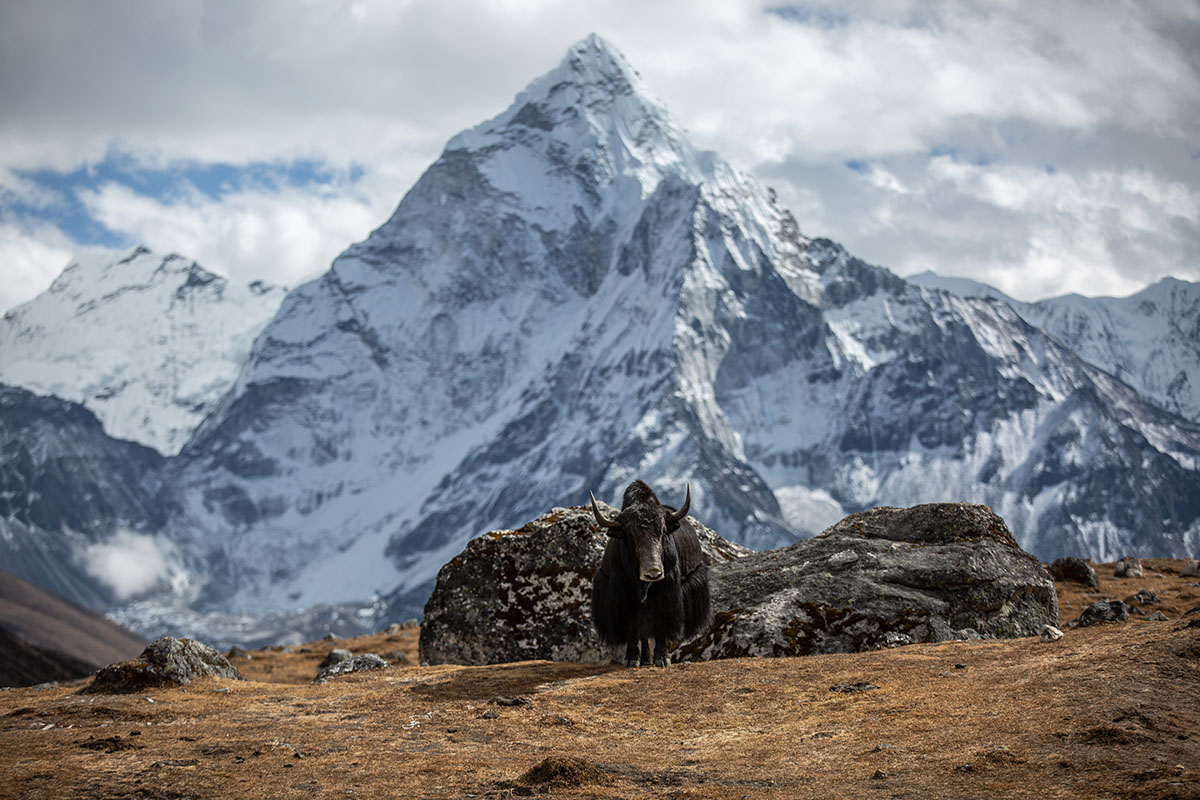
Brian was also excited to discover that the British staple of baked beans, fried eggs, and toast was on the menu, a pleasant change to a menu of dal bhat, fried rice, and momos. Sharing in his excitement were a couple of young Welsh lads who had also come over Chola Pass and were staying in the teahouse. With full bellies, we shared stories of our day and other travels while the clouds rolled in over Ama Dablam.
En route from Dzongla to Lobuche, the trail rejoins the main trail to Everest Basecamp and becomes busier with trekkers. At our teahouse in Lobuche, we met a couple from Israel, an American, and a Chilean—the place seemed to be bustling compared to the accommodations of the previous evenings. We again had time to relax in Lobuche and hiked up a ridge to see the notorious Khumba glacier that streamed from the base of Everest. The nights continued to get colder, and we hung our extra clothing and jackets by the window to reduce drafts. We both slept in our parkas and were thankful for our -18°C sleeping bags.
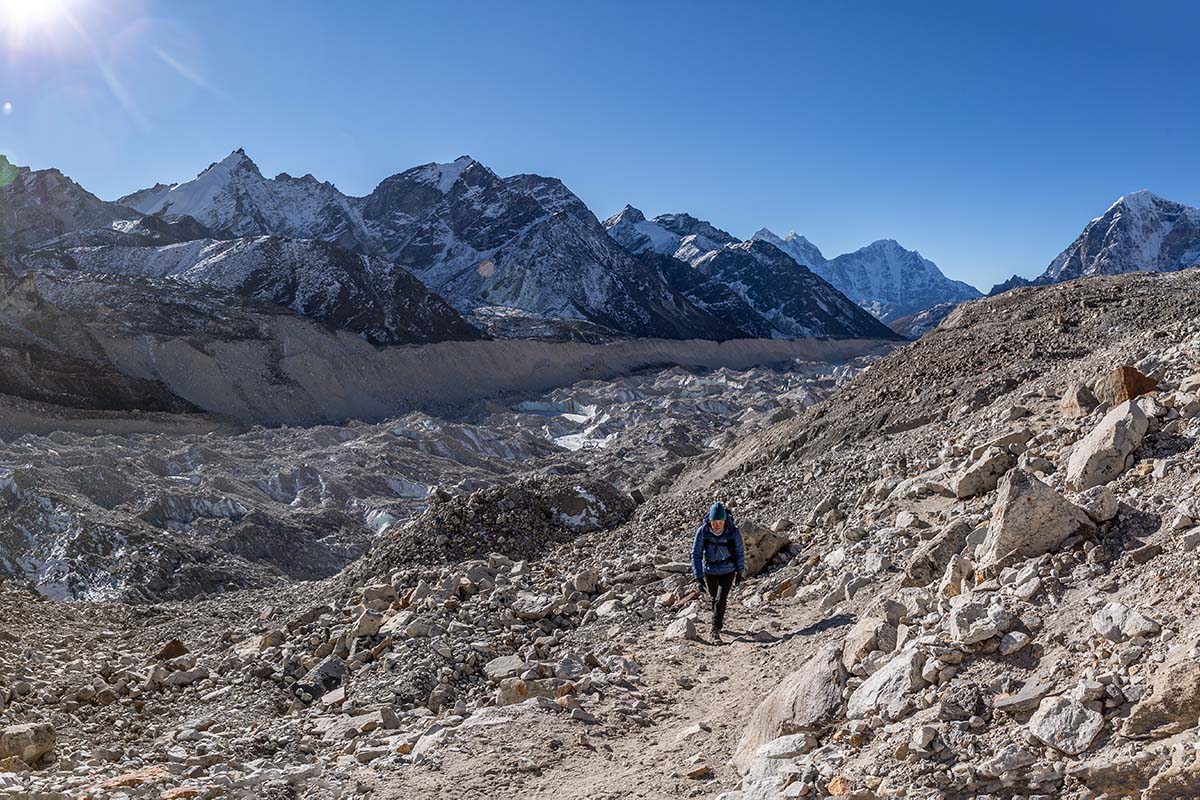
Gorak Shep is a couple hours' hike from Lobuche and, at almost 5,200 meters, is the last village before Everest Basecamp. Views of Everest, Nuptse, and Pumori greeted us as we clambered over the rocky trail to get there. When we arrived, there wasn't a cloud in the sky, so rather than wait for the next morning's sunrise behind Everest as many do, we chose to summit Kala Patthar that evening in order to watch the sun's last rays on the world's highest peak.
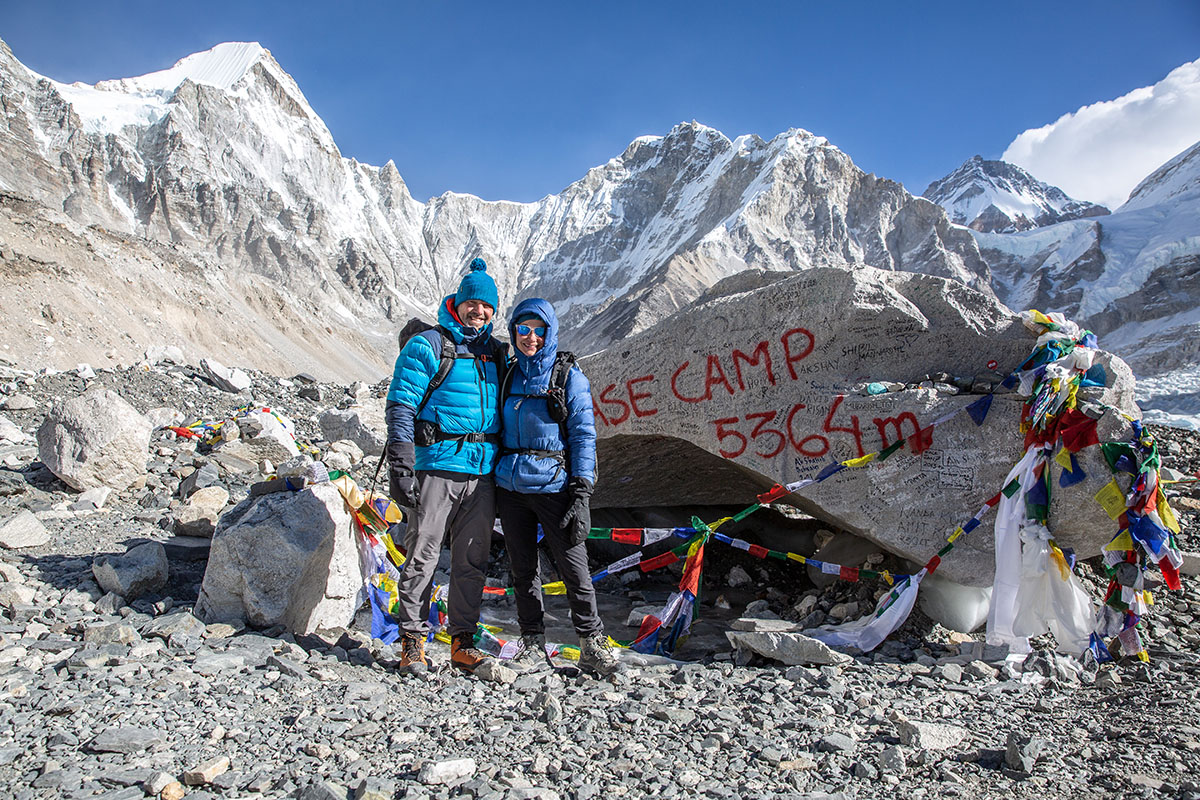
We left for Kala Patthar with plenty of time to enjoy the panoramic views of the Himalayas. The hike to 5,644 meters was straightforward, and though our bodies could now handle the altitude, the thinner air was noticeable. With each step, the views became more spectacular, and Everest became more apparent as it peaked out behind Lho La and Lotse. The winds became frigid and whipped at the prayer flags marking the summit. We were about an hour early for sunset, but the extra time allowed us to bundle up and find a more sheltered location from which to watch the sunset on Everest as the sky turned pink. At first, the entire range lit up before us, but as the sun dipped, the final rays lingered on Changtse, Everest, and Nuptse, and within seconds, only Everest glowed. It was an emotional moment—the highlight of our trek—and will always be etched in our memories
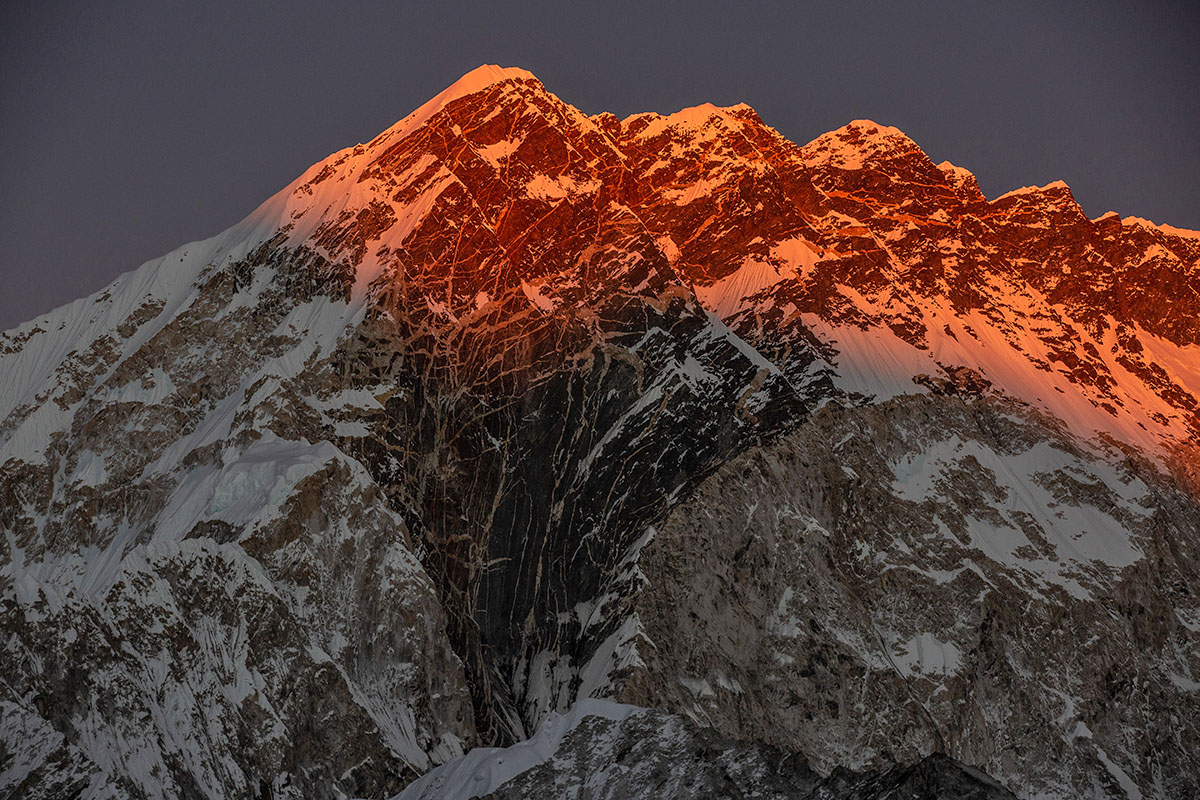
Our next morning, after the fitful sleep common at high altitudes, we walked to Everest Basecamp, affectionately referred to as EBC. Visiting the basecamp had not been a priority for either one of us, but because we were so close, it seemed a shame to avoid this popular destination. The trail from Gorak Shep crosses desert-like sand and winds through rocky dunes and the lateral moraine of the Khumbu Glacier before ultimately reaching the glacier itself.
We had relatively low expectations, but as we reached our destination, we were both amazed by the beauty of the Khumbu icefall and its spectacular jagged towers, glacial blue at their base. We were the only ones there, and the location was truly awe-inspiring. It was hard to imagine tents on this uneven and rocky terrain, and it increased our respect for the predominantly Sherpa crews who create platforms for expeditions.
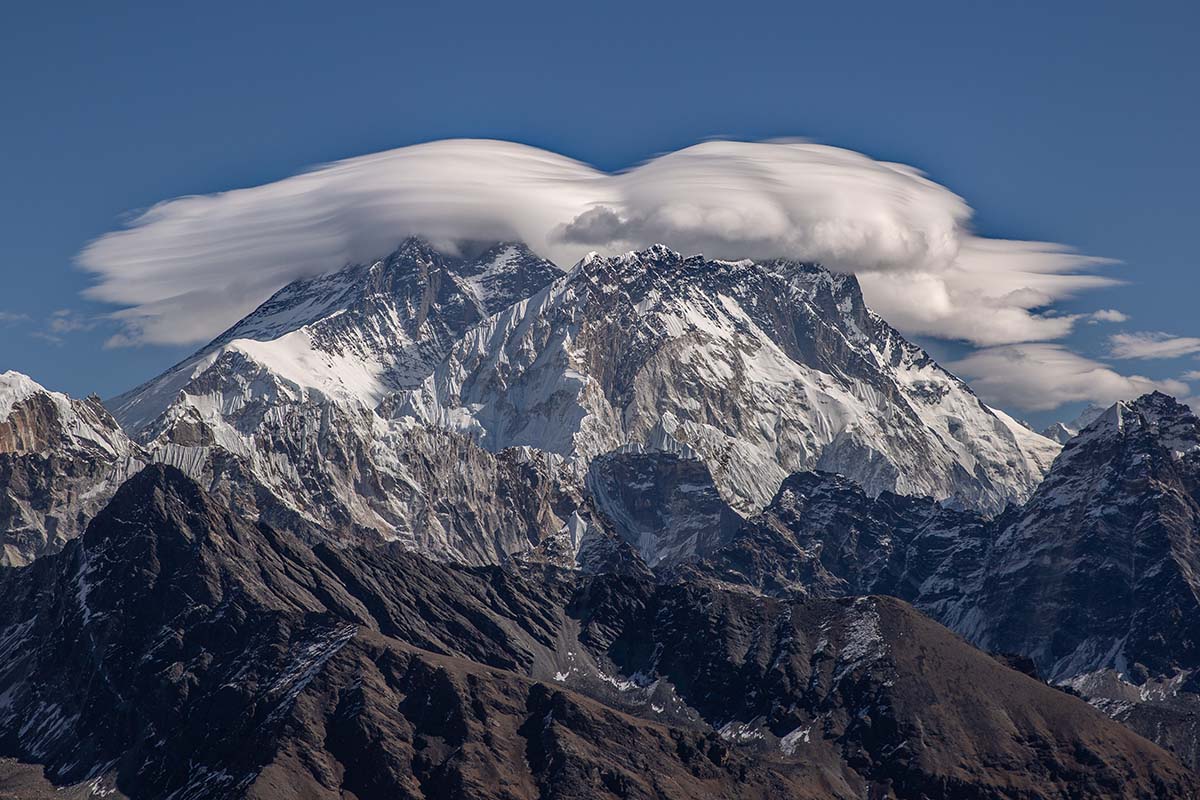
The wind picked up on our way back to Gorak Shep, blasting debris as we tightened our hoods to deflect sand from our eyes. The days of hiking were starting to take a toll on Brian's knees, and the altitude was messing with his digestion. Again, we joked and questioned why we never just book a beach vacation. Though the idea of tropical temperatures and oxygen-rich air appealed, a simple glance around at the magnificent peaks provided our answer.
We ate lunch, packed up, and descended the 300 meters back to Lobuche for the night. I discovered that I'd forgotten my favorite après pants (Patagonia Nano-Air) at our last teahouse, and we almost had to tackle our porter Prashant to stop him from running the several hours back to retrieve them. We also conceded that at that point, Brian's knees were not up for another pass and that instead we would hike to picturesque Dingboche, close to Ama Dablam's base the next day. Any disappointment at missing the Kongma La pass was displaced by the promise that there would now be time for someone to bring my beloved pants from Lobuche.
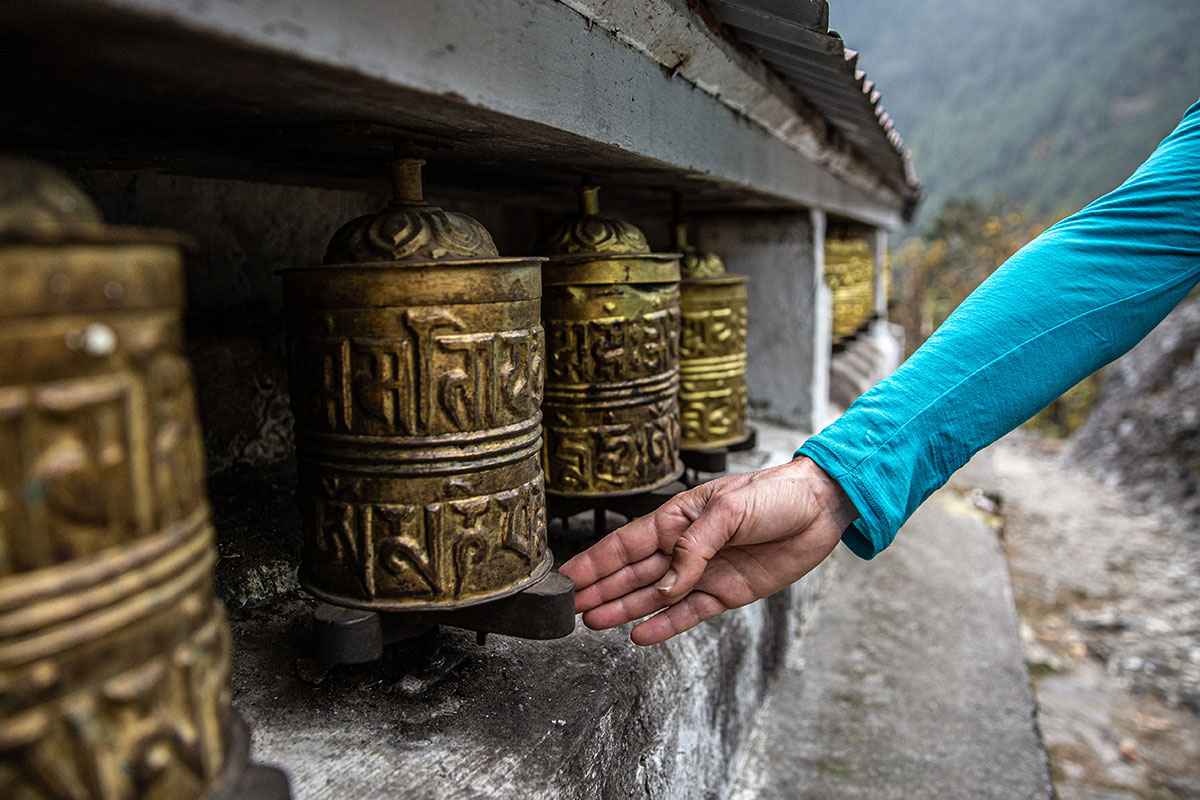
In the morning, we learned that my pants had been sent the previous night by a man on a horse. It was clear that he had forgotten to stop and my Nano-Airs were now MIA. We began our descent to Dingboche and stopped at the first teahouse. Ramesh learned that the man on the horse was evacuating someone suffering from altitude sickness and, in his haste, had forgotten to drop off my pants.
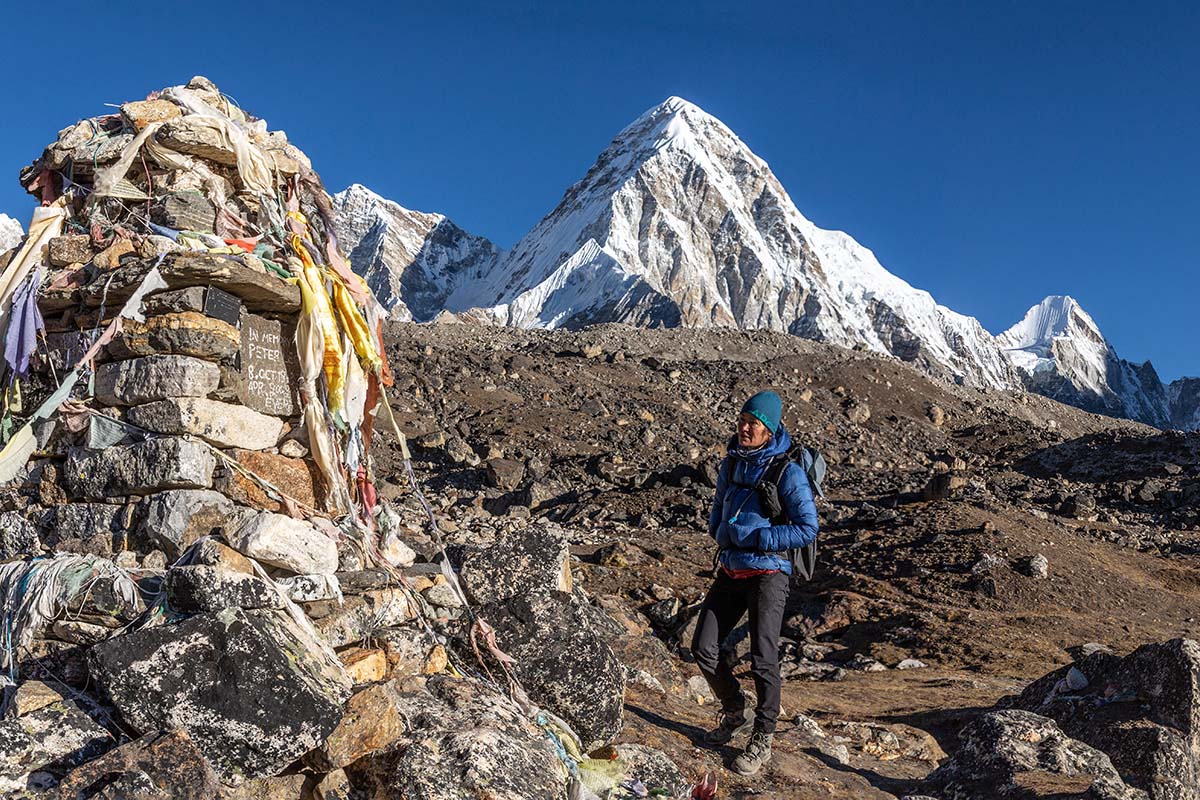
Our day took us past the stupas, or memorials, dedicated to those who'd lost their lives in the nearby mountains. The epitaphs revealed that, unsurprisingly, most had succumbed while descending Everest, and each memorial spoke to the power of nature and the mountains. I found it hard to leave this stunningly beautiful and somber setting. We carried on in silence, lost in our own thoughts as the magnificent Ama Dablam hovered over us.
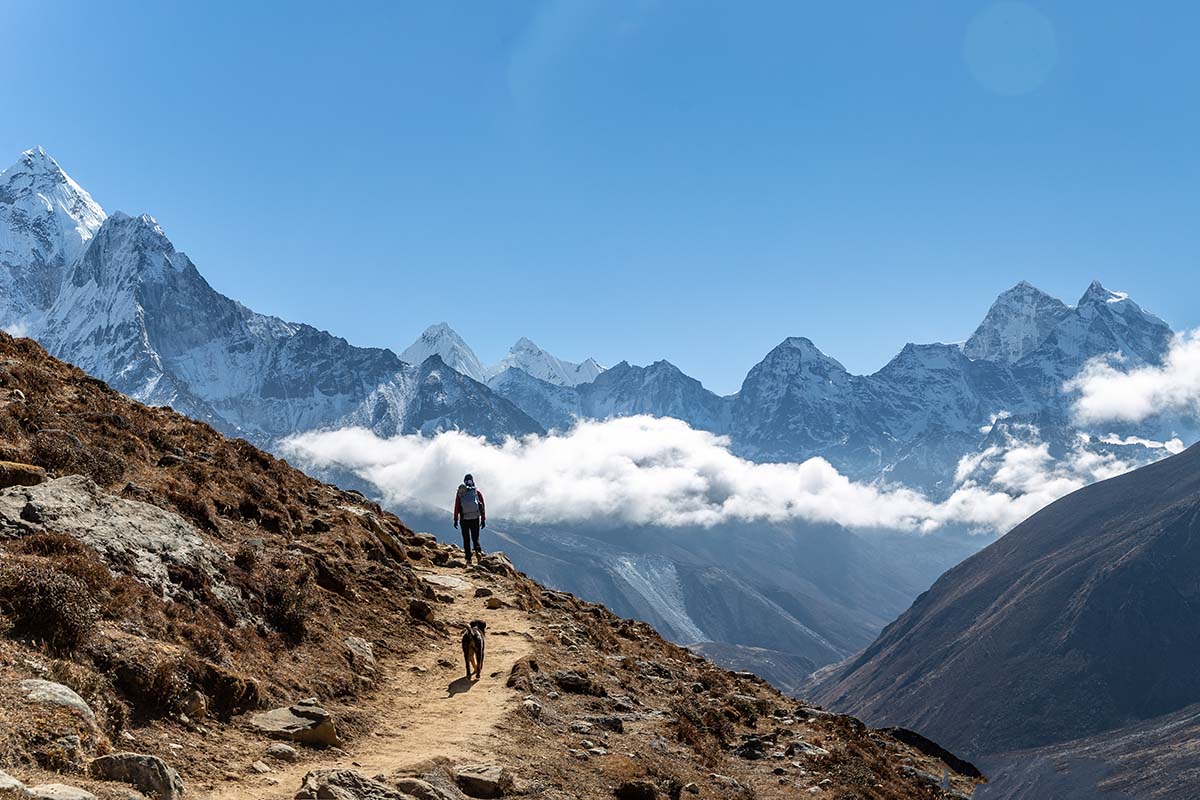
Spruce shrubs appeared, the first we'd seen since Lungden on our fourth day, and grew taller as we continued, making it clear we were descending. Dingboche is nestled at the foot of our new favourite mountain, Ama Dablam, and because it's on the Everest Basecamp trail, caters to trekkers with bakeries and coffee shops. We were unsuccessful in our search for ibuprofen for Brian, but played with a litter (or two) of 13 friendly puppies that were denned near our teahouse. And to my delight, Prashant ran to the nearby villages, gathering intel, and ultimately handed me my Nano Air bottoms.
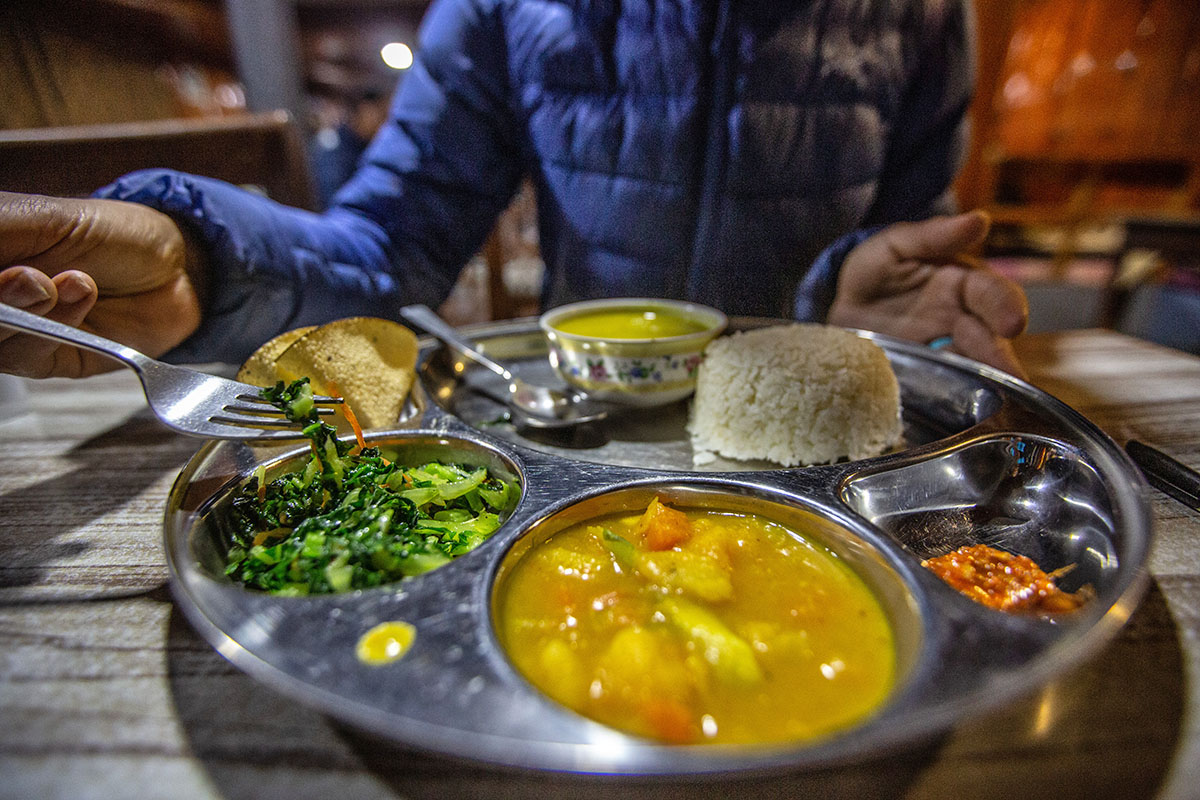
From Dingboche, we continued to descend, the shrubs brushing our knees and eventually growing to the height of trees. As we approached Tengboche, the trail undulated through rhododendrons, pine, and red-barked Himalayan birch. We saw our last yak and trains of bell-clad donkeys and dzo again appeared. In Tengboche, we visited the monastery and sat inside as the monks chanted amongst lighting and textures that had Brian wishing that photos were allowed.
With only a few days of trekking ahead, retracing our steps from Namche to Lukla, our trek was coming to a close, and our conversations turned to the familiar meals we looked forward to. Now, 3400 meters felt like sea level, and in Namche, we enjoyed a beer for the first time in weeks. We were reminded that in Namche, the hundreds of dogs who are silent through the day bark all night.
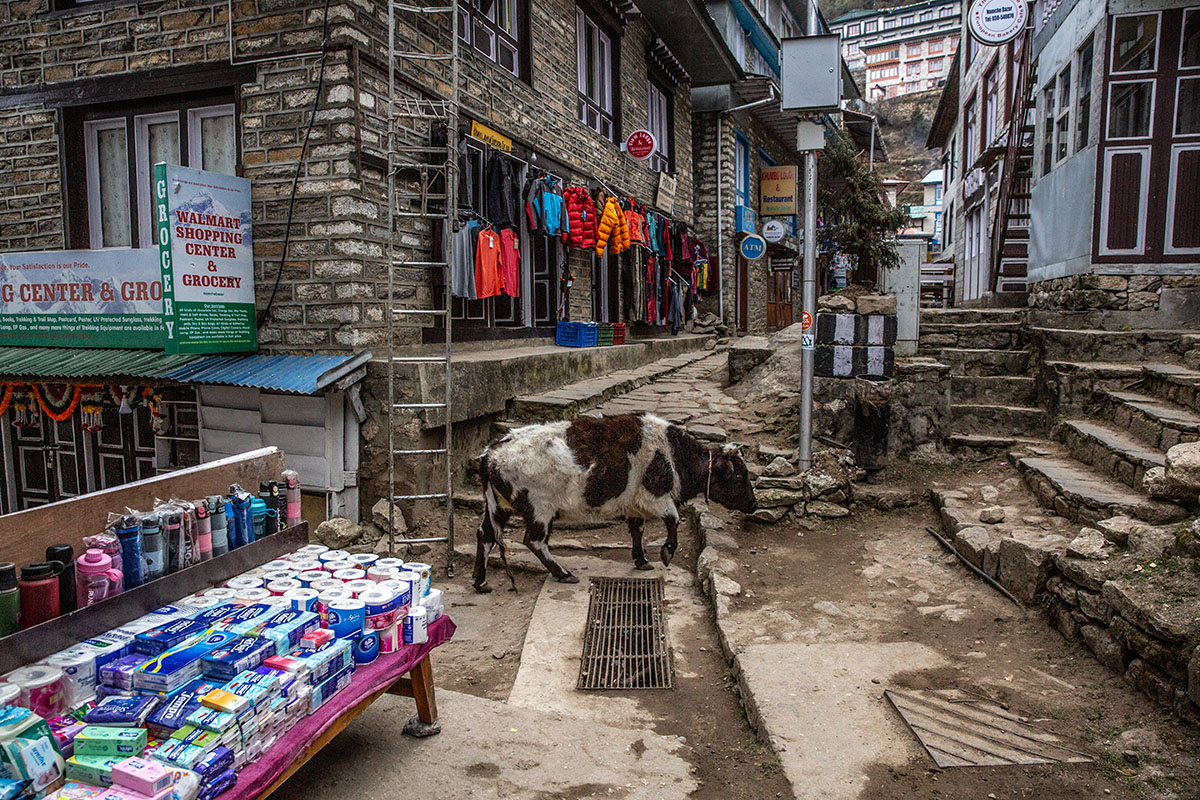
The land appeared lush, marigolds and roses bloomed and the gardens were full. The places that had been exotic two weeks prior now felt familiar as we crossed the numerous suspension bridges over the Dudh Koshi river. We felt a sense of reflection and completeness upon leaving the Sagarmāthā (Everest) National Park for Lukla. The experience was deeply etched in our souls.
We'd had mere hours in Kathmandu prior to our trek, but before our flight home, we had two whole days. Put simply, Kathmandu is an assault on the senses. Air pollution stings the eyes, cars and motorcycles use their horns with reckless abandon, and the restaurants, incense shops, and litter on the streets overwhelm with fragrances. We walked to Swayambhunath Stupa, the monkey temple, and passed stores spilling over with colorful gear, beads, clothing, and freshly butchered meats. Side-stepping to avoid being clipped by a motorcycle and ducking below electric wires, we wandered and explored. The Garden of Dreams and our favorite restaurant, an authentic Italian pizzeria, provided a quiet reprieve from the chaos. It was hard to reconcile that this city is a gateway to the serenity found in the highest mountain range on Earth.
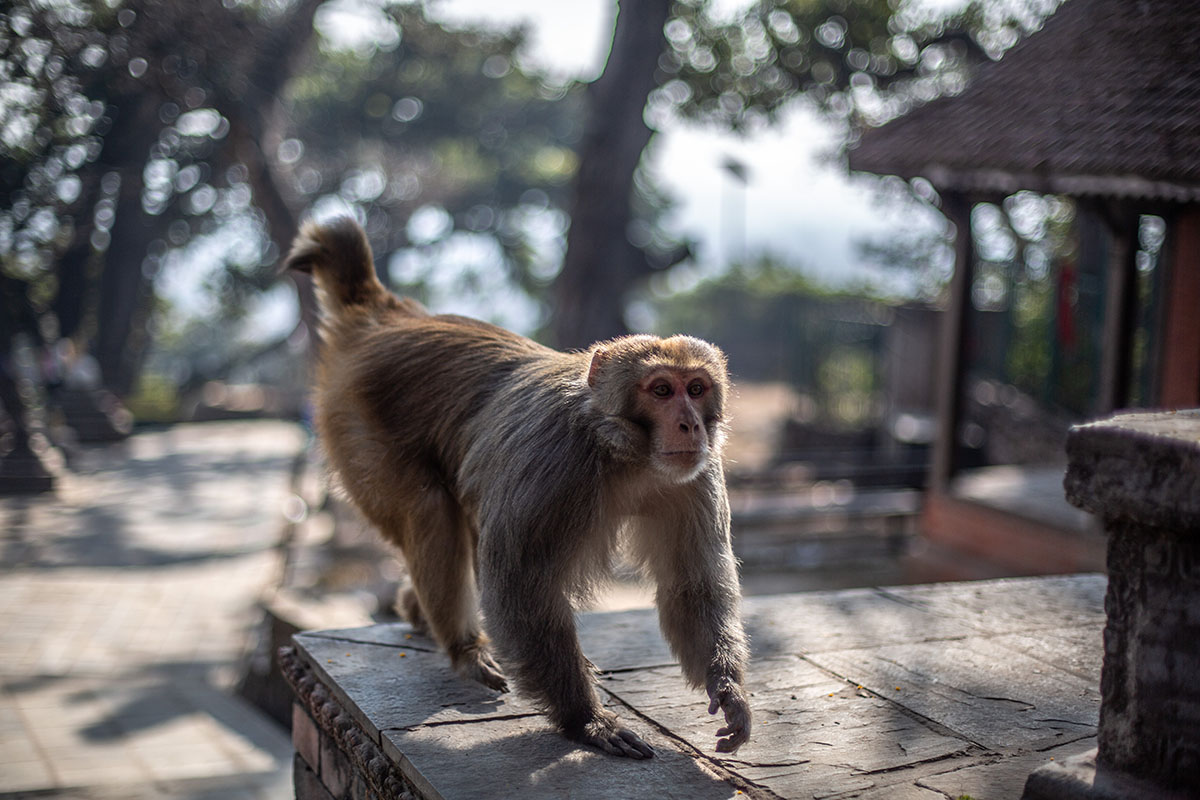
While we were in Nepal, catastrophic floods ravished our home province of British Columbia, and a new COVID variant emerged. Though we heard murmurings, we were largely unaware of the news and instead immersed in the enchantment of the Himalayas. When we re-emerged, the world felt jagged and difficult to fit back into, and Katmandu was overwhelming. Our time in these special mountains provided us with a much-needed break, and we will always carry their beauty and magic with us.
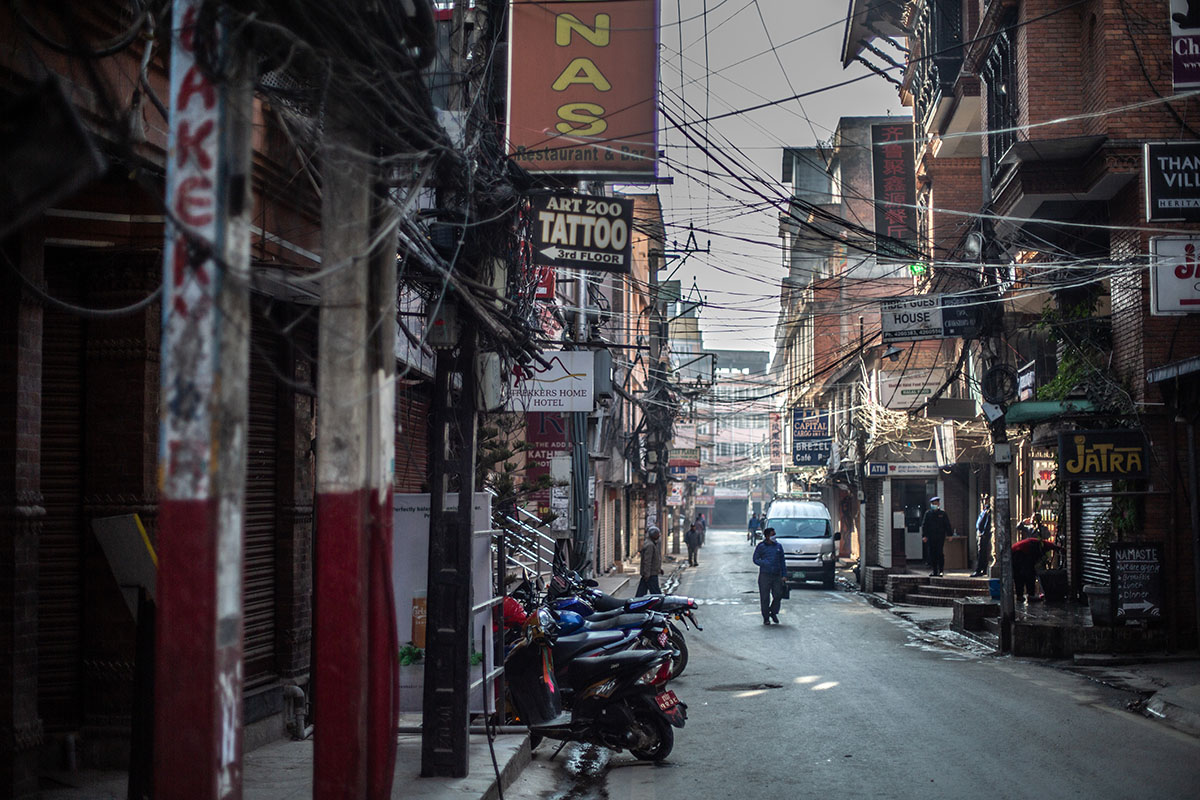
Trekking company? Guide or no guide? Porter? Brian and I struggled with whether to hike self-supported (as we typically do) or whether to hire a trekking company. Ultimately, our two-week window for the trek and the complexities caused by the global pandemic had us choose the relative ease of a trekking company. With this, we would have a private guide. We still considered going without a porter, but the cost saving would have been $250 for 16 days, and they appealed to our conscience, pointing out that we would be helping the Nepalese trekking economy, and one man in particular, after a year of dormancy. We still carried fairly loaded full-sized backpacks, but having a porter did allow us to bring some luxury items. We had no regrets.
It is important to note here that the laws for whether you can hike alone seem to be rather murky. Technically, on April 1, 2023, Nepal mandated that trekkers must hire a guide if they plan to be anywhere in Nepal’s 12 national parks and six conservation areas. This includes the Annapurna and Manaslu circuits and the EBC (Everest Base Camp). We have heard conflicting reports from our community and beyond about the lack of enforcement regarding this, with many people still hiking and climbing solo. Be that as it may, we encourage you to do your research, respect the local laws, and consider that hiring a guide helps to support the local community—one that is heavily impacted by foreigners both positively and negatively.
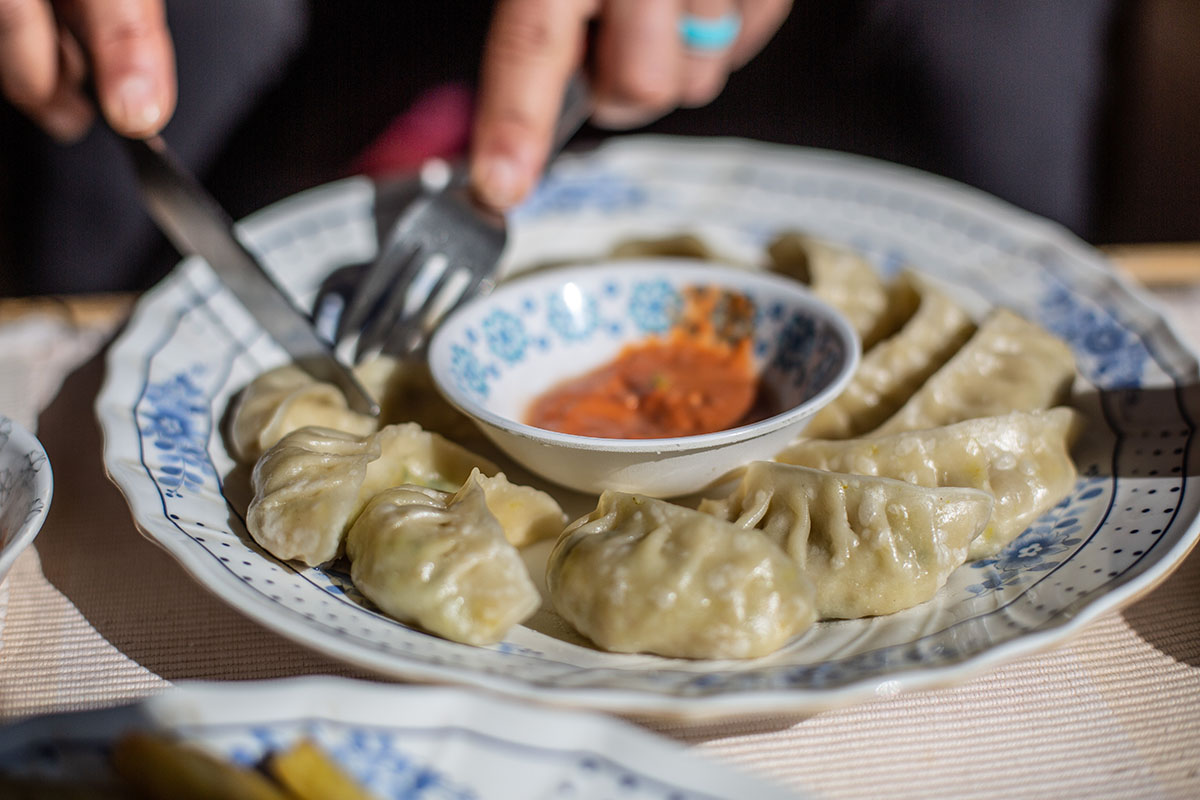
The three passes, or any hike in the Everest region, would be simple without a guide, particularly in low season when it's easy to find accommodation in tea houses. In keeping with our desire to support the local economy, we opted for a Nepal-based company rather than an international one. There are many companies—be sure to get one that's licensed. We chose Adventure Treks Nepal and would recommend this company. Both our guide, Ramesh, and our porter, Prashant, were excellent, and we became friends. Gyan, the owner, answered all our questions and had us over for a fantastic dinner with his family on our last night.
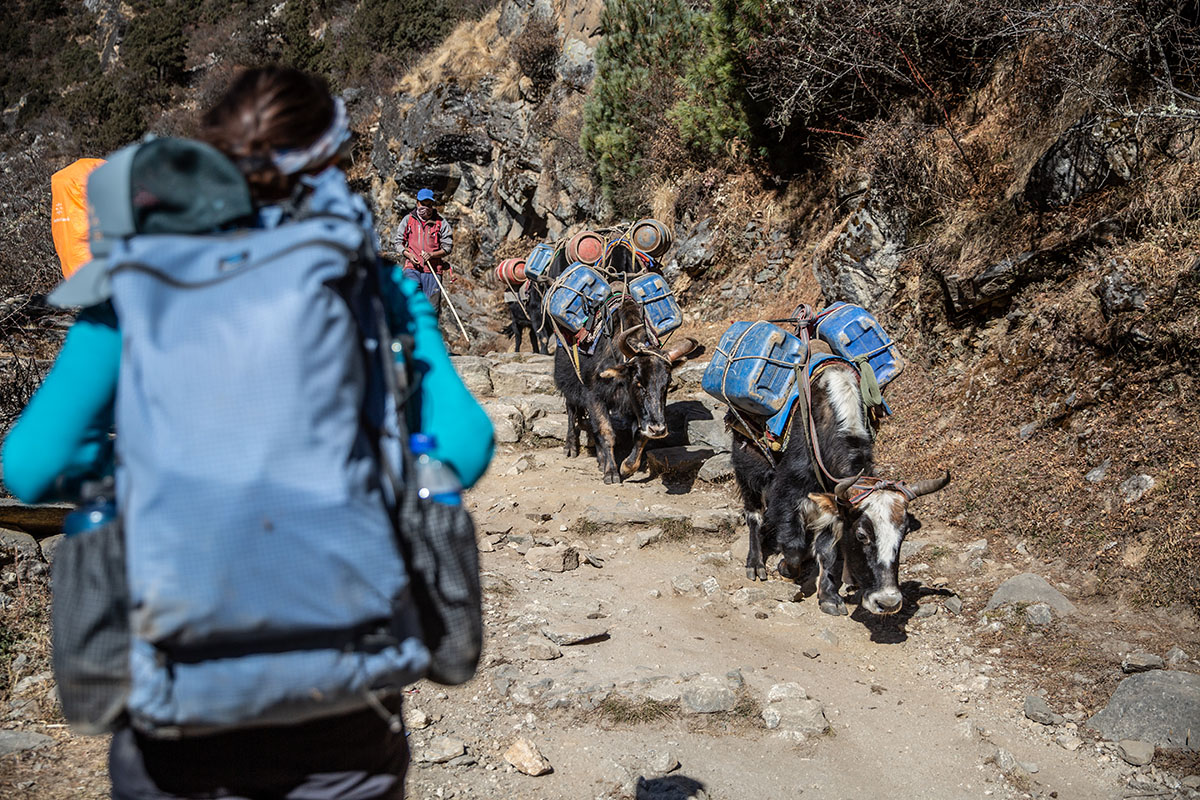
We embarked on this journey in November 2021, and at that time, fully vaccinated visitors were not required to quarantine. This changed on December 15, 2021, the day we arrived home. To clear immigration at the time of our trip, we also needed a completed CCMC (COVID-19 Crisis Management Center) document, proof of vaccination, and a negative PCR test. This form is no longer required, and as of May 26, 2023, neither a certificate of vaccination nor a negative PCR test are required for entry or exit. It is important to be aware of ever-changing entry and exit requirements.
We also had to provide proof of a hotel booking, our trekking permit, proof of insurance covering trekking, and our boarding passes, though most of this likely is no longer needed. The trekking company took care of the permit and hotel, which was helpful, but we still recommend checking the current requirements for your home country and Nepal. The U.S. Department of State or (in our case) the Government of Canada websites are great places to start.
Kathmandu airport is somewhat chaotic, and in order to obtain a visa, we had to first complete a form at a computer terminal, take a picture of the completed form, and hand over our phone with the picture at the cashier's wicket so they could copy the information. Once we'd paid the fee for a 30-day visa, we could then enter the line to see an immigration agent.
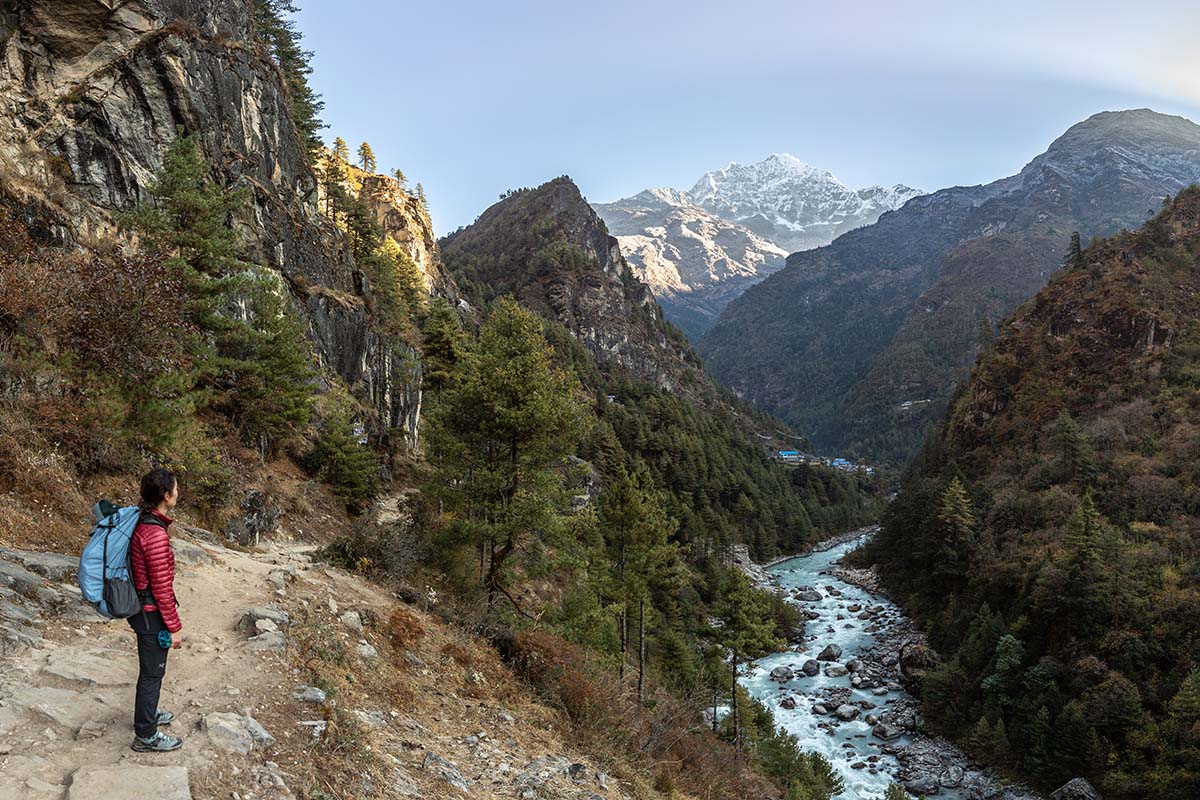
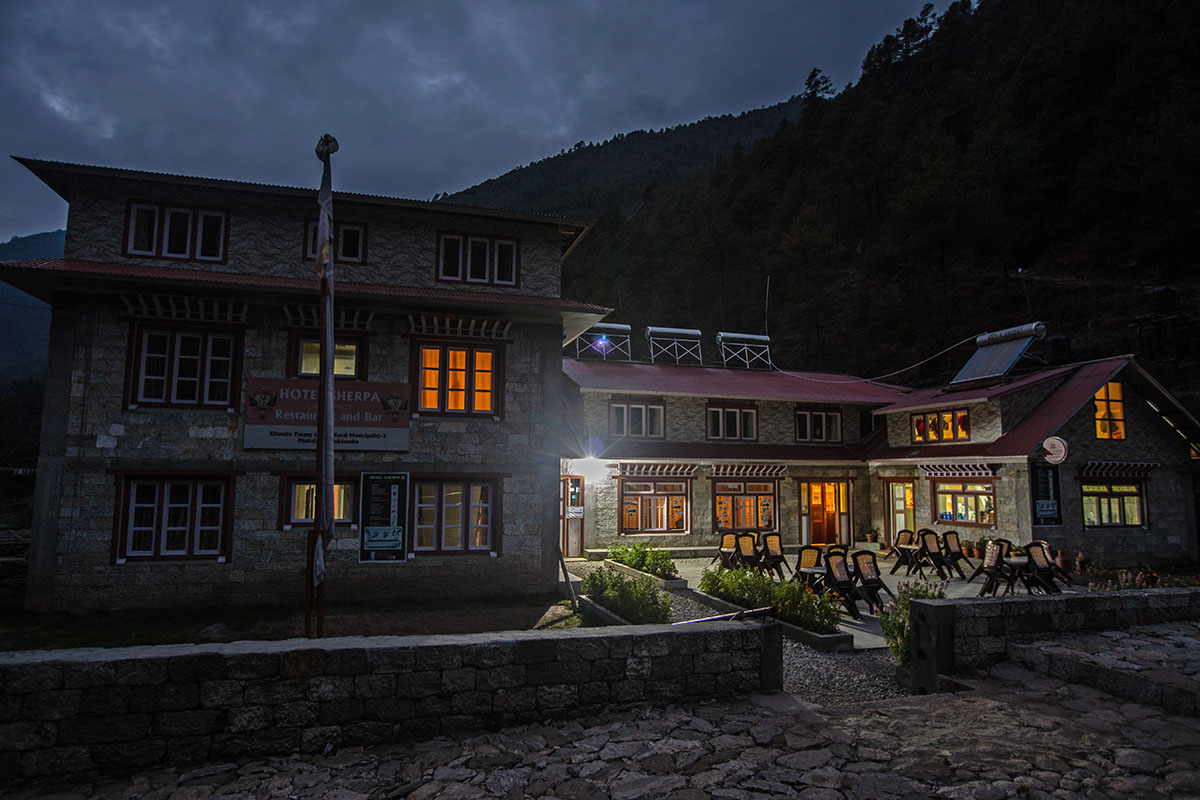
While trekking, we stayed in teahouses, which are lodges that provide rooms and food. For independent trekkers, they are generally quite affordable, and you can also take your meals there. We always had a room to ourselves, often with an attached bathroom. We were traveling toward the end of the trekking season and were often the only guests.
The teahouses offer a wide variety of food options. Be prepared to eat dal bhat (lentils/curry/rice), momos (dumplings), fried rice, pasta, or "mountain pizzas," which are surprisingly tasty. We heeded warnings and ate only vegetarian food (Brian's longest meat-free stint!). For breakfast, pancakes, French toast, oatmeal, and omelets were always on the menu.
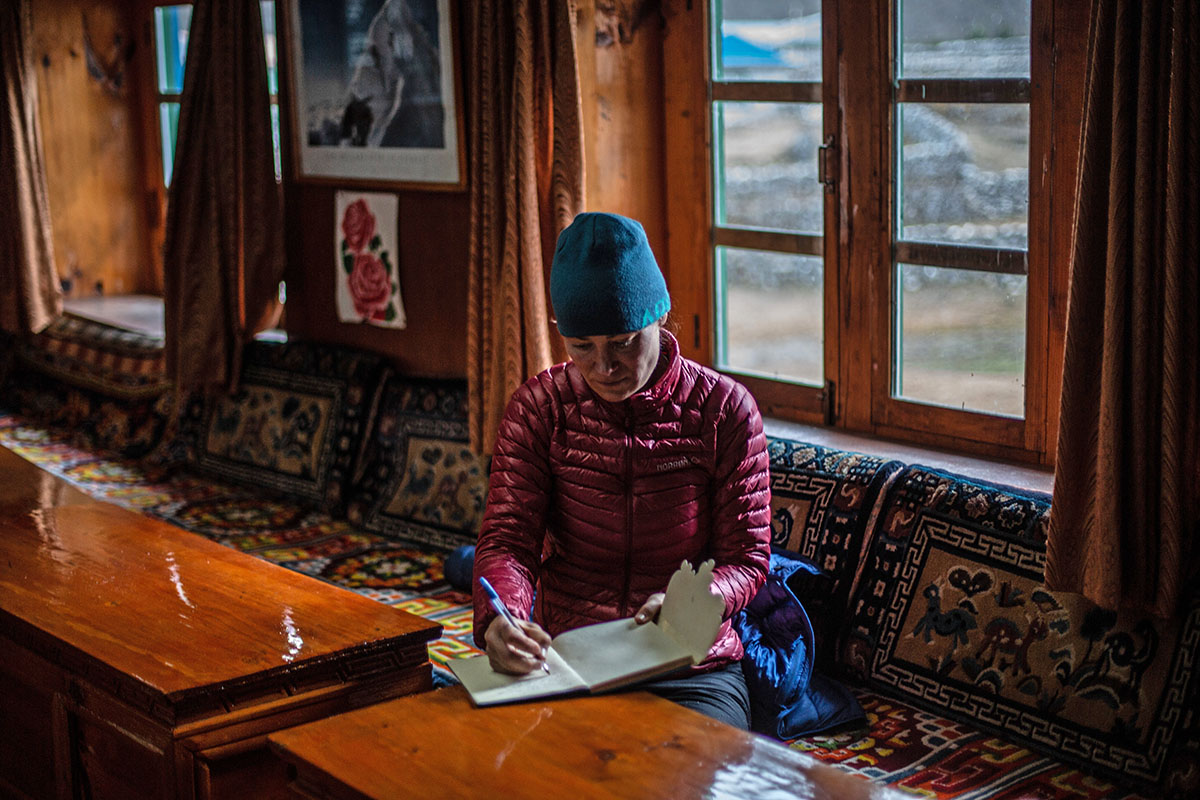
The local water should not be consumed. Be careful about fresh vegetables and fruit (we only ate oranges and bananas because they could be peeled, and only ate cooked vegetables). Bottled water is available at the teahouses, but the price increases dramatically at higher, more remote locations. In Namche, for example, one liter was under $1 USD, whereas in Gorak Shep, one liter cost almost five times that price.
Most of the teahouses have Wi-Fi for a cost. The prices range and also tend to get more expensive as you ascend. At the time of our trip, in the lower teahouses, Wi-Fi was about 500 rupees (~$3.75 USD); in the higher elevations, a 10gig card cost 2500 rupees. Most teahouses provide the ability to charge devices (a phone might cost 250 to 500 rupees). We also brought a solar charger and battery pack.
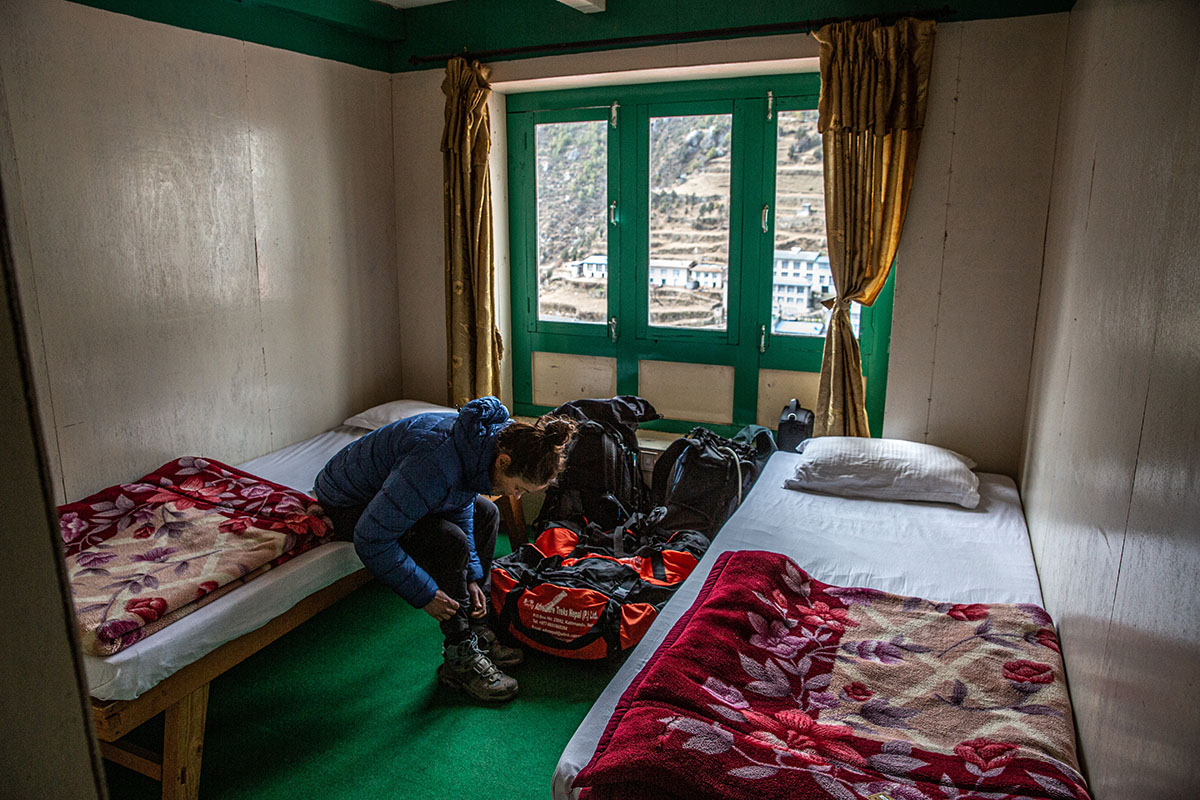
We stayed at the Hotel Thamel in the Thamel area, which is popular with tourists. The staff was friendly and helpful and allowed us to keep our room the entire day of our departure rather than enforcing a check-out time. Breakfast was substantial, and the coffee was delicious. We also left our luggage there while trekking.
